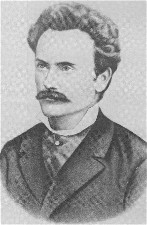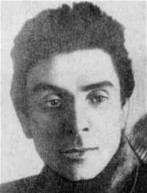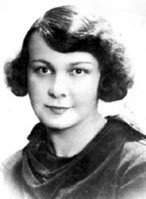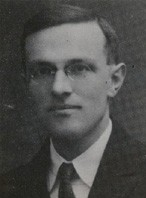IEU'S FEATURED TOPICS RELATED TO THE LITERARY CULTURE OF UKRAINE
I. The Literature of Kyivan Rus': Chronicles, Lives of Saints, Epics
II. The Polemical Literature of the 16th to 18th Centuries
III. Ukrainian Literature of the Late Baroque Period (18th Century)
IV. Ivan Kotliarevsky and the Origins of Modern Ukrainian Literature
V. The "Ruthenian Triad" and Western Ukrainian National Revival
VI. Taras Shevchenko, Panteleimon Kulish, and Ukrainian Romanticism
VII. Populist Writers in Russian-ruled Ukraine (Late 19th and Early 20th Century)
VIII. Ivan Franko and the Western Ukrainian Populists and Radicals
IX. Ukrainian Modernist Writers of the Late 19th and Early 20th Century
X. The Moloda Muza and Ukrainian Modernist Literature in Western Ukraine
XI. Mykola Khvylovy, Vaplite, and the Ukrainian Cultural Renaissance of the 1920s
XII. Mykola Zerov and the Ukrainian Neoclassicists
XIII. Ukrainian Literary Avant-Garde of the 1910s and 1920s
XIV. The 'Fellow Travelers' in Soviet Ukrainian Literature of the 1920s
XV. The Yiddish-Language Writers of Kyiv's Kultur Lige
XVI. Socialist Realism in the Soviet Ukrainian Literature
XVII. The 'Prague School' and the Ukrainian Nationalist Writers of the Interwar Period
XVIII. The 'Minor Renaissance' of Ukrainian Literature in the 1940s
XIX. The New York Group and Postwar Emigre Modernist Literature
XX. Shistdesiatnyky: The Literary Generation of the Post-Stalinist Thaw in Ukraine
XXI. Ukrainian Dissident Writers of the 1960s to 1980s
 I. THE LITERATURE OF KYIVAN RUS': CHRONICLES, LIVES OF SAINTS, EPICS
I. THE LITERATURE OF KYIVAN RUS': CHRONICLES, LIVES OF SAINTS, EPICS
The development of original literature in Kyivan Rus' was based on both a rich folk oral tradition and a dissemination of translated religious texts. The Christianization of Ukraine in 988 gave impetus to a propagation of various adaptations (from the Balkan Slav originals) and translations (mainly from Greek) of religious texts. The oldest and most noted Kyivan didactic work is 'A Sermon on Law and Grace' (1050) by Metropolitan Ilarion, the first native metropolitan of Kyiv. A more subtle form of didactic literature can be found in the numerous hagiographic works, describing the lives of saints. Modeled on translated hagiographies, lives of Saint Anthony of the Caves, Saint Volodymyr the Great, Saint Princess Olha, and others were written and collected in the Kyivan Cave Patericon, the most remarkable collection of lives in the Kyivan period. Also noteworthy are the early chronicles, which are unique for their wealth of information and their blending of fact and fiction, written sources and eyewitness accounts. Quite prevalent were apocryphal writings as well as translated tales. Also popular was the first 'travelogue' by Hegumen Danylo about his pilgrimage to the Holy Land (ca 1100). The most unusual and outstanding monument of old Ukrainian literature, however, is the secular epic poem Slovo o polku Ihorevi (The Tale of Ihor's Campaign). Particularly rich in poetic tropes (epithets, similes, metaphors, metonymy, hyperbole, and personification), the work suggests a sophistication indicative of a rich tradition of folk and martial literature with highly developed poetics. But the plea of the anonymous author for unity among the princes fell on deaf ears. The Kyivan Rus' state, disunited, was too weak to withstand the onslaughts from the East. Kyiv fell to the Mongols in 1240, and the Principality of Galicia-Volhynia became the focus of political and cultural life in Ukrainian lands. The incorporation of Volhynia into the Grand Duchy of Lithuania (1340) marks the end of the period and of significant literary activity... Learn more about Ukrainian medieval literature by visiting the following entries:
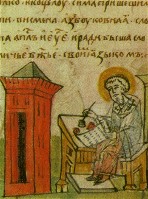
|
CHRONICLES. The Ukrainian chronicles are the most remarkable monuments of historical literature produced in ancient Rus'. They can be divided into three parts, the Primary Chronicle (up to the 12th century), the Kyiv Chronicle (from 1118 to 1190), and the Galician-Volhynian Chronicle (from the beginning of the 13th century to 1292). They were written as annual records or annals. Besides accounts of events they contain a variety of literary materials--stories, legends, biographies, and borrowings from Byzantine chronicles. The so-called Primary Chronicle of 1097 was based on three earlier compilations and became in its turn the source for Povist' vremennykh lit (ca 1111), whose authorship is traditionally attributed to the monk Nestor the Chronicler. Povist' served as the basis for later chronicles composed in monasteries and princely courts in Kyiv and other cities of Rus'. It was continued by the so-called Kyiv Chronicle of the 12th century. The Chernihiv, Pereiaslav, and Galician chronicles did not survive, but excerpts from them have been preserved in other chronicle collections. With the fall of Kyiv and the shift of political power to the Principality of Galicia-Volhynia in the mid-13th century, chronicle writing became concentrated in these territories and produced the Galician-Volhynian Chronicle, which was written at the end of the 1280s and is the main source for the history of this period... |
| Chronicles |
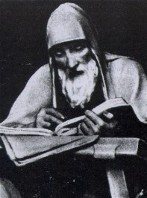
|
NESTOR THE CHRONICLER (Nestor litopysets), b ca 1056, d ca 27 October 1114 in Kyiv. Famous medieval hagiographer and chronicler; saint in the Ukrainian church. He entered the Kyivan Cave Monastery at 17 and was a hierodeacon under Hegumen Stefan of Kyiv (1074-8). He participated in the ceremonial disinterment of the relics of Saint Theodosius of the Caves in 1091. He was one of the most educated men in late 11th- and early 12th-century Kyivan Rus', renowned for his knowledge of theology, history, literature, and Greek. Nestor wrote the lives of Saints Borys and Hlib and Saint Theodosius of the Caves in the 1080s, and he supplemented and continued the text of the Rus' Primary Chronicle (written in 1093), and completed its redaction, known as Povist' vremennykh lit (The Tale of Bygone Years), ca 1111-13. The original has not been preserved. Most scholars (eg, Dmytro Abramovych, Mykhailo Braichevsky, Dmytro Chyzhevsky, Mykhailo Hrushevsky, D. Likhachev, M. Priselkov, Omeljan Pritsak, Aleksei Shakhmatov, Mykhailo Vozniak) consider Nestor the Hagiographer and Nestor the Chronicler to be one person. Some (eg, Evgenii Golubinsky, P. Kazansky, Aleksei Sobolevsky), however, believe they are different persons... |
| Nestor the Chronicler |
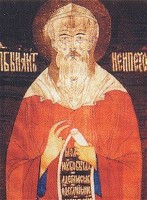
|
HAGIOGRAPHY (LIVES OF SAINTS). Biographies, tales, and legends about saints, including accounts of miracles performed by them, particular episodes from their lives, and their martyrdom. These writings are among the most important monuments of old Ukrainian literature. By the 11th century there were already many translations of Greek and Latin hagiographic writings, individual lives of saints, patericons (collections of episodes from lives of monks), reading menologies (collections of lives and sermons arranged according to the church calendar, not for liturgical use but for daily reading), and prologues or synaxaries (collections similar to menologies but with abridged lives). Original works written in Ukraine include the Lives of Saints Borys and Hlib and the Life of Saint Theodosius of the Caves, both by Nestor the Chronicler, the beautifully composed Tale and Passion and Glorification of the Holy Martyrs Borys and Hlib, and the Life of Prince Mstyslav I Volodymyrovych. The lives of Saint Volodymyr the Great, Saint Princess Olha, Mykhailo Vsevolodovych of Chernihiv, and Boyar Fedir have come down to us only in later redactions. Fragments of the Life of Saint Anthony of the Caves and the Life of Prince Ihor Olhovych have been preserved in the chronicles. The Kyivan Cave Patericon is an important monument of hagiographic literature... |
| Hagiography |
KYIVAN CAVE PATERICON. A collection of tales about the monks of the Kyivan Cave Monastery. The original version arose after 1215 but not later than 1230 out of the correspondence of two monks of the monastery--monk Simon (by then the bishop of Suzdal and Vladimir) and monk Polikarp, who used the epistolary form as a literary device. The letters contain 20 tales about righteous or sinful monks of the monastery based on oral legends and several written sources, such as the Life of Saint Anthony of the Caves and the Kyivan Cave and Rostov chronicles, which have not survived. Most of the original text deals with events of the 11th century. It varies from brief accounts of particular facts to novella-like or novel-like narratives. Most of the tales tend to be antisecular in tone and favor a strict, ascetic life. Nevertheless, some do testify to the decline of monastic life (some monks, for example, own property). Besides chronological data about the monastery, the text contains a wealth of historical and cultural information about monastic and secular life. Because of its relatively simple style and its rich vocabulary, as well as its masterly characterization of individuals by means of dialogue, prayer, and 'internal monologue,' the patericon is one of the outstanding works of Old Ukrainian literature... |
|
| Kyivan Cave Patericon |
_s.jpg)
|
HOMILETICS (SERMONS). The art of religious discourse and preaching of sermons, homilies, and catechetical instruction. It has been practiced in Ukraine since its Christianization in the late 10th century, when it was employed to propagate the new religion. Slavic homilies were initially introduced from Bulgaria; new ones were then locally created or translated from the Greek. The oldest extant Rus' sermon is the panegyrical 'Slovo o zakoni i blahodati' (Sermon on Law and Grace, 1051) by the eloquent Metropolitan Ilarion, the first non-Greek metropolitan of Kyiv. The work has had an important influence on Ukrainian and other Slavic literatures. Other famous Rus' preachers were Hegumen Moisei of the Vydubychi Monastery, the author of 'Pokhvalne slovo' (Sermon of Praise, 1198), and Bishop Cyril of Turiv (d 1182), who freely dramatized events from the Gospel. Alongside didactic sermons, describing the duties of monks, condemning paganism and social inequality, and exhorting the faithful to observe the church's teachings, a genre of Byzantine rhetoric dealing with the fine points of theology was fostered. Homiletics in Kyivan Rus' evolved until the Mongol invasion and the sacking of Kyiv in the mid-13th century, after which it was continued on a lesser scale in the Principality of Galicia-Volhynia, which was less affected by the invasions from the east... |
| Homiletics (Sermons) |
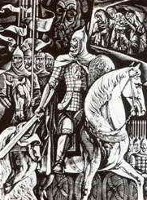
|
SLOVO O POLKU IHOREVI [The Tale of Ihor's Campaign]. An epic poem of the late 12th century written by an anonymous author. Its subject is the unsuccessful campaign mounted in the spring of 1185 by Ihor Sviatoslavych, prince of Novhorod-Siverskyi, against the Cumans. Its central theme is the fate of the territories of Rus'. In addressing that theme the author condemns the various princes for their feuding and their selfishness at the expense of the general good. The poem was written in an epic lyrical style. The historical subject matter is interspersed with dreams, laments, nature's reaction to the hero's fate, monologues of princes, and other motifs and devices. Particularly rich in poetic tropes (epithets, similes, metaphors, etc.), the work suggests a sophistication indicative of a rich tradition of folk and martial literature with highly developed poetics. The language of the work is the contemporary Rus' literary language, similar to that of the chronicles, but with a marked increase in the incidence of the vernacular. A wide range of scholars, particularly Mykhailo Maksymovych, demonstrated connections between the Slovo and Ukrainian folk poetry. The original manuscript perished in the Moscow fire of 1812. The want of an original allowed a number of critics to consider the work a falsification of a later date. The majority of scholars, however, believe it to be authentic... |
| Slovo o polku Ihorevi |
The preparation, editing, and display of the IEU entries associated with the literature of medieval Rus'-Ukraine were made possible by the financial support of the CANADIAN FOUNDATION FOR UKRAINIAN STUDIES.
 II. THE POLEMICAL LITERATURE OF THE 16TH TO 18TH CENTURIES
II. THE POLEMICAL LITERATURE OF THE 16TH TO 18TH CENTURIES
The Cossack period, or the Middle period of Ukrainian literature, began in the 16th century. It was a historical time of great unrest and political upheaval which culminated in the Cossack-Polish War of 1648-54, and of religious strife between the Uniates and the Orthodox, which centered around the Church Union of Berestia in 1596. Yet this period is also noted in Ukraine for its vibrant and varied cultural activity. One important mode of literary culture that arose as a consequence of religious controversy over the Church Union of Berestia was a rich polemical literature written in Old Ukrainian and in Old Polish, rarely in Church Slavonic. The stormy religious and political polemics were initiated by the Polish Jesuits Piotr Skarga and Benedykt Herbest, who harshly criticized the institutional and spiritual 'vices' of the Orthodox church. In response the Orthodox published two treatises by Herasym Smotrytsky of the Ostrih Academy which were followed by a multitude of works by various authors; these works varied in size and form from short, sharply worded 'epistles' to long scholarly exposes. From a literary point of view, the most important place in the polemical literature of the period is occupied by a brilliant stylist and maximalist defender of Orthodoxy and Eastern asceticism, Ivan Vyshensky... Learn more about the Ukrainian polemical literature of the 16th to 18th centuries by visiting the following entries:
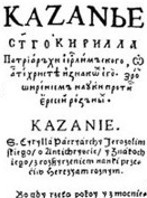
|
POLEMICAL LITERATURE. Publicistic and literary writings on religious and church issues and on national politics. In Ukraine and Belarus polemical literature dates back to the religious denominational struggles of the 16th and 17th centuries, especially those in conjunction with the 1596 Church Union of Berestia, but also those that were part of the general European processes of the Reformation and the Counter-Reformation. Initiatially the leading role in the polemics on the side of the Orthodox was assumed by writers associated with the Ostrih Academy, including Prince Kostiantyn Vasyl Ostrozky himself. Along with the Ostrih polemicists, Ivan Vyshensky, the most outstanding publicist in Ukrainian literature, stepped into the fray against the Catholics. The leading Uniate polemicist was Ipatii Potii. Meletii Smotrytsky first directed his polemics against the the Uniates but then changed his allegiance, and figured prominently as the author of several treatises against the Orthodox. Polemical works were also written by the Orthodox metropolitan of Kyiv Petro Mohyla... |
| Polemical literature |
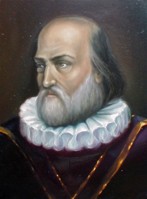
|
SMOTRYTSKY, HERASYM, b ? in Smotrych (now in Dunaivtsi raion, Khmelnytskyi oblast), d October 1594. Writer and teacher; father of Meletii Smotrytsky. He was secretary at the Kamianets-Podilskyi county office and in 1576 was invited by Prince Kostiantyn Vasyl Ostrozky to Ostrih, where he became one of the leading activist members of the Ostrih intellectual circle. In 1580 Smotrytsky became the first rector of the Ostrih Academy. He was one of the publishers of the Ostrih Bible, to which he wrote the foreword and the verse dedication to Prince Ostrozky. The dedication is one of the earliest examples of Ukrainian versification (nonsyllabic) and is somewhat reminiscent of Ukrainian dumas. Smotrytsky's polemical works against those betraying the Orthodox faith and a satire on the clergy have been lost. Only his book, Kliuch tsarstva nebesnoho (Key to the Heavenly Kingdom, 1587), which is the first printed example of Ukrainian polemical literature, has survived... |
| Herasym Smotrytsky |
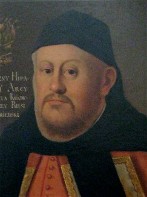
|
POTII, IPATII, b 12 April 1541 in Rozhanka, Podlachia region, d 1613. Churchman and Uniate metropolitan of Kyiv. The son of a nobleman, he was raised at the Polish royal court, and attended a Calvinist school. After attending Cracow University he entered the service of King Sigismund II August. Potii was continually involved in religious affairs. Having adopted Calvinism, he reconverted to Orthodoxy in 1574. At the initiative of Prince Kostiantyn Vasyl Ostrozky he was made bishop of Volodymyr-Volynskyi and Brest in 1593. As bishop he began formal negotiations with Roman Catholic representatives, and in 1595 he was sent to Rome as a representative of the church in Ukraine, to set forth its confession of faith before Pope Clement VIII. He returned to lead the sobor that culminated in the Church Union of Berestia. After the proclamation of the union Potii was one of its leading supporters, both in defending it against Orthodox opposition and in seeking equal rights with Roman Catholics in the Polish-Lithuanian Commonwealth...
|
| Ipatii Potii |
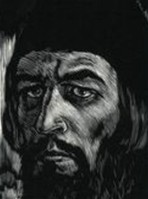
|
VYSHENSKY, IVAN, b ca 1550 in Sudova Vyshnia, Galicia, d after 1620 in Mount Athos, Greece. Orthodox monk and polemicist. He passed some of his youth in Lutsk and was connected with the Ostrih Academy scholars. Ca 1576-80 he entered a monastery at Mount Athos. There are 15 known works by Vyshensky: seven epistles, six treatises, a dialogue, and a story. His most important works were directed against the Church Union of Berestia and were written in the late 1590s. In 1600-1 he prepared a collection of the 10 works he had written by then and sent it to the Lviv Dormition Brotherhood. Vyshensky's writings stand out among Ukrainian polemical works of the 16th and 17th centuries by virtue of both their literary merit and their ideological content. He did not simply reject the Uniate church and Catholicism. Grounded in Byzantine asceticism, he sharply criticized temporal life and the entire church hierarchy and secular hierarchy and urged a return to the simplicity of old Christian brotherhood in order to bring about God's Kingdom on earth... |
| Ivan Vyshensky |
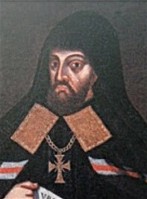
|
SMOTRYTSKY, MELETII, b 1577 in Smotrych, Podilia, d 27 December 1633 at the Derman Monastery, Volhynia. Philologist, churchman, and polemicist; son of Herasym Smotrytsky. He studied at the Ostrih Academy; the Jesuit college in Vilnius; and, from 1605, in Leipzig, Nuremberg, and Wittenberg. In 1608, he returned to Vilnius to teach at the Orthodox brotherhood school. There he wrote his famous defense of the Orthodox church, Trenos... (Threnos..., 1610). He is believed to have served as a professor and rector of the Kyiv Epiphany Brotherhood School in 1618-20. In 1620 he was consecrated archbishop of Polatsk. During the next three years he wrote several polemical tracts. Smotrytsky travelled to Constantinople and the Holy Land, and after his return he joined the Uniate church, in 1627. In 1627-8 he negotiated with Yov Boretsky and Petro Mohyla in an attempt to re-create a united Ruthenian church in union with Rome but under its own patriarch... |
| Meletii Smotrytsky |
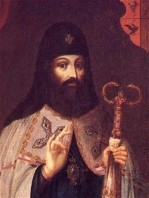
|
MOHYLA, PETRO, b 10 January 1597 in Moldavia, d 11 January 1647 in Kyiv. Ukrainian metropolitan, noble, and cultural figure; son of Simeon, hospodar of Wallachia (1601-2) and Moldavia (1606-7), and the Hungarian
princess Margareta. After his father's murder in 1607, Mohyla and his mother sought refuge in Western Ukraine. He was tutored by teachers of the Lviv Dormition Brotherhood School, and pursued
higher education in theology at the Zamostia Academy and in Netherlands and France. After his return to Ukraine he entered the military service and fought as an
officer in the Battle of Cecora (1620) and Battle of Khotyn (1621). In 1621-7 he received estates in the Kyiv region and became interested in affairs of the
Ukrainian Orthodox church. In September 1627 a dietine in Zhytomyr chose Mohyla to succeed the late Zakhariia Kopystensky as archimandrite of the influential Kyivan Cave Monastery... |
| Petro Mohyla |
The preparation, editing, and display of the IEU entries featuring the Ukrainian polemical literature of the 16th to 18th centuries were made possible by the financial support of the STEPHEN AND OLGA PAWLUK UKRAINIAN STUDIES ENDOWMENT FUND at the Canadian Institute of Ukrainian Studies (Edmonton, AB, Canada).
 III. UKRAINIAN LITERATURE OF THE LATE BAROQUE PERIOD (18TH CENTURY)
III. UKRAINIAN LITERATURE OF THE LATE BAROQUE PERIOD (18TH CENTURY)
Although the Cossack period in Ukrainian literature lasted until the end of the 18th century, it had begun to decline with the signing of the Pereiaslav Treaty of 1654. A crisis in the Ukrainian literary culture became particularly acute at the end of the baroque period in the 18th century, when Ukraine came under ever-increasing Russian domination. In 1709 Hetman Ivan Mazepa in league with Charles XII of Sweden, failed in his attempt to wrest Ukraine from Russian control. In 1723 the Hetman state lost the right to choose its own hetmans. As a result of Tsar Peter I's church reforms, numerous Ukrainian bishops and churchmen received ecclesiastical offices in Russia and were forced to leave Ukraine. Among them were the leading Ukrainian writers of the time Stefan Yavorsky, Dymytrii Tuptalo, and Teofan Prokopovych. Much of the Ukrainian literature of the baroque period was written in the Ukrainian redaction of Church Slavonic, the language of the Ukrainian church. (Polish, Latin, and the Ukrainian vernacular were also used by various Ukrainian writers.) However, in 1720 Peter banned all ecclesiastical printing in Ukrainian by decree, and the government-enforced process of Russification of the Ukrainian literature began. Various elements of Russian entered the Ukrainian literary language and the bookish language of the educated class grew consistently farther away from the Ukrainian vernacular. By the end of the 18th century, in order to have their works printed, most Ukrainian writers were compelled to write in Russian or (as in the late works of Hryhorii Skovoroda) in a language close to Russian including various Ukrainianisms. Also important in ending the Cossack period in Ukrainian literature was the rise of classicism in literature. Classicism recognized different registers of language: odes, tragedies, and scholarly writings were written in the high style (ie, the scholarly language; in Ukraine at the time that meant Russian); drama and prose were relegated to the middle style (a mixture of the bookish and the vernacular spoken by clerks and other literate people); and only comedy, burlesque, and travesty were written in the low style (the language of the peasantry; in 'Little Russian,' Ukrainian). Nonetheless, the literature of the Ukrainian baroque had a great influence on Russian literature from the first third of the 17th century up to the mid-18th century. It also had an influence on the Southern Slavs (Mykhail Kozachynsky) and left some traces in Polish literature... Learn more about the Ukrainian literature of the 18th century by visiting the following entries:
_s.jpg)
|
TUPTALO (ROSTOVSKY), DYMYTRII (secular name: Danylo), b December 1651 in Makariv, Kyiv region, d 8 November 1709 in Rostov, Russia. Saint, writer, theologian, and churchman. He studied at the Kyivan Mohyla Academy in 1662-5 and entered Saint Cyril's Monastery in Kyiv in 1668 and in 1675 was ordained a hieromonk. During the next 30 years he was hegumen of several Ukrainian and Belarusian monasteries. In 1701 Peter I summoned him to Moscow, where he was consecrated metropolitan on 23 March 1701. In 1702 he was sent to Rostov. Tuptalo was associated with a group of Ukrainian hierarchs in the Russian church, led by Metropolitan Stefan Yavorsky, who did not accept some radical changes favored by Peter, especially the subordination of the church to the state. Tuptalo's first published work was Runo oroshennoie (The Bedewed Fleece, 1680), a collection of stories about miracles attributed to the icon of the Mother of God in Chernihiv. His most important work is his menaion for daily reading, a major collection of the lives of saints (first published in Kyiv in 1689-1705). This collection is the best example of Ukrainian hagiography of the 17th and 18th centuries. Tuptalo was a well-known orator, and a collection of his sermons (some of which criticized the reforms of Peter I) appeared in 1909. He also wrote polemical literature, theological treatises, and historical studies. The language Tuptalo used in his theological works was Old Church Slavonic, but it contained many Ukrainianisms. His sermons and menaion were close to the Ukrainian vernacular, but were Russified by order of the Russian Holy Synod... |
| Dymytrii Tuptalo (Rostovsky) |
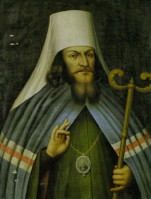
|
YAVORSKY, STEFAN (secular name: Semen), b 1658 in Yavoriv, Galicia, d 27 November 1722 in Moscow. Orthodox hierarch, theologian, poet, and philosopher. A graduate of the Kyivan Mohyla College (ca 1684), he completed his education in Polish Jesuit colleges: he studied philosophy in Lviv and Lublin and theology in Poznan and Vilnius. After returning to Kyiv in 1687, he renounced Catholicism, became an Orthodox monk (1689), and taught rhetoric (1690), philosophy (1691-3), and theology (1693-8) at the Kyivan Mohyla Academy. In 1700 he was appointed metropolitan of Riazan and Murom in Russia, and on 1 December 1701, exarch in Moscow of the Russian Orthodox church, by Emperor Peter I. Yavorsky helped Peter to reform the church and education. Eventually his defense of church autonomy, criticism of Peter, opposition to Teofan Prokopovych, and intolerance of Protestantism cost him the tsar's favor. In 1712 he was forbidden to preach, and in 1718 he was forced to live in Saint Petersburg and subjected to constant harassment and political inquiry. In 1721 Peter appointed him president of the Holy Synod, an institution Yavorsky abhorred. Yavorsky wrote religious verses and panegyrics (eg, to Hetman Ivan Mazepa and Peter I), polemical treatises, and baroque sermons. His major work is the anti-Protestant dogmatic treatise Kamen' very... (The Faith's Rock..., 1718). In his philosophical lectures in Kyiv he presented the scholastic systems of logic, physics, and metaphysics; he often sided with J. Duns Scotus and William of Ockham against the Thomists... |
| Stefan Yavorsky |
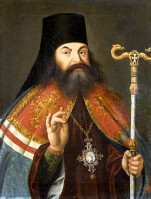
|
PROKOPOVYCH, TEOFAN (secular name: Eleazar), b 18 June 1681 in Kyiv, d 19 September 1736 in Saint Petersburg. Orthodox archbishop, writer, scholar, and philosopher. He graduated from the Kyivan Mohyla Academy in 1696 and continued his education in Lithuania, Poland, and Rome. In 1704 he returned to the Mohyla Academy to teach poetics, rhetoric, philosophy, and theology. He also served as prefect from 1708 and rector in 1711-16. He gained prominence as a writer and as a supporter of Hetman Ivan Mazepa. His most famous work, Vladimir, is dedicated to the hetman, whom he depicted as the figure of the Grand Prince of Kyiv. Following Mazepa's unsuccessful revolt against Peter I in 1709, however, Prokopovych denounced him and expressed his complete allegiance to Peter. He became a favorite of Peter's and was called to Saint Petersburg to be a preacher and adviser to the tsar. In the 1720s Prokopovych played a crucial role in the reform of the Russian Orthodox church. He supported the liquidation of the position of patriarch and the creation of the Holy Synod under the direct authority of the tsar. Prokopovych's most notable contribution to Ukrainian literature was the drama Vladimir (1705). His other poetic works include a panegyric on the Battle of Poltava in Ukrainian, German, and Latin; various elegies; and other works. He also wrote an authoritative textbook on poetics, but after his departure to Saint Petersburg, Prokopovych lost contact with Ukrainian literary development. His subsequent works were all in Russian and often devoted to praising Peter I and his imperial reforms... |
| Teofan Prokopovych |
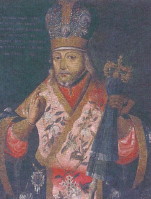
|
HORLENKO, YOASAF (secular name: Yakym), b 19 September 1705 in Pryluky, Poltava region, d 21 December 1754 in Hraivoron, Slobidska Ukraine. Church leader and writer. He was a grandson of a Pryluky Cossack colonel and on his mother's side a grandson of Hetman Danylo Apostol. During his studies at the Kyivan Mohyla Academy he took his monastic vows, and after graduating lectured at the academy (1729-31). In 1737 he became hegumen of the Mhar Transfiguration Monastery, and in 1748 bishop of Belgorod and Oboian (which included the later eparchies of Kharkiv, Kursk, and a part of Chernihiv). Horlenko rebuilt churches, raised the moral and educational level of the clergy, and supported Kharkiv College. He wrote a brief autobiography, several sermons, and a dramatic poem, Bran' chesnykh sedmi dobrodetelei z sedmi grekhami smertnimi (The Struggle of the Seven Cardinal Virtues with the Seven Deadly Sins, 1737). His works were written in Old Church Slavonic, but they contained many Ukrainianisms. He was venerated by the common people and in 1911 was canonized by the Orthodox church... |
| Yoasaf Horlenko |
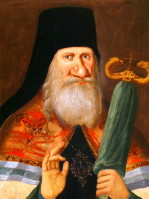
|
KONYSKY, HEORHII (secular name: Hryhorii; aka Yurii), b 20 November 1717 in Nizhyn, d 13 February 1795 in Mahiliou, Belarus. Orthodox bishop and church figure of noble descent. Konysky graduated from the Kyivan Mohyla Academy in 1743, then served there as a professor of poetics, rhetoric, philosophy, and theology (1745–55) and as rector (1752–5). He was consecrated bishop of Mahiliou and Belarus in 1775 and elevated to archbishop in 1783. In these posts he tried to return Uniates to the Orthodox church. In 1757 he founded a theological seminary in Mahiliou. A prolific writer, Konysky wrote many baroque poems; the play Voskreseniie mertvykh (Resurrection of the Dead, published in Letopisy russkoi literatury, 1860); a philosophical textbook Philosophia peripatetica quadripartita (1747–51), which remained unpublished; and historical works such as Prawa i wolnosci obywatelów Korony Polskiej i Wielkiego Ksiestwa Litewskiego (The Rights and Freedoms of the Citizens of the Polish Kingdom and the Grand Duchy of Lithuania, 1767) and Istoricheskoe izvestie o Belorusskoi eparkhii (Historical Information about the Belarusian Eparchy, 1776). Konysky was also considered by some scholars to have been the author of Istoriia Rusov (History of the Rus'). His collected works, in two volumes, were published in 1835 (2nd edn 1861) and his sermons in 1892... |
| Heorhii Konysky |
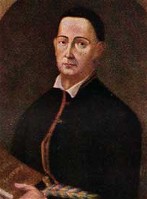
|
SKOVORODA, HRYHORII, b 3 December 1722 in Chornukhy, Lubny regiment, d 9 November 1794 in Pan-Ivanivka, Kharkiv vicegerency (now Skovorodynivka near Zolochiv, Kharkiv oblast). Philosopher and poet. He was educated at the Kyivan Mohyla Academy (1734-53, with two interruptions). He sang in Empress Elizabeth I's court Kapelle in Saint Petersburg (1741-4), served as music director at the Russian imperial mission in Tokai, Hungary (1745-50), and taught poetics at Pereiaslav College (1751). He spent the next 10 years in Kharkiv, teaching poetics (1759-60), syntax and Greek (1762-4), and ethics (1768-9) at Kharkiv College. After his dismissal from the college he abandoned any hope of securing a regular position and spent the rest of his life wandering about eastern Ukraine, particularly Slobidska Ukraine. Material support from friends enabled him to devote himself to reflection and writing. Although there is no sharp distinction between Skovoroda's literary and philosophical works, his collection of 30 verses (composed from 1753 to 1785) titled Sad bozhestvennykh pesnei (Garden of Divine Songs), his dozen or so songs, his collection of 30 fables (composed between 1760 and 1770), his translations of Cicero, Plutarch, Horace, Ovid, and Muretus, and his letters, written mostly in Latin, are generally grouped under the former category. Some of his songs and poems became widely known and became part of Ukrainian folklore. His philosophical works consist of a treatise on Christian morality and 12 dialogues... |
| Hryhorii Skovoroda |
The preparation, editing, and display of the IEU entries about the Ukrainian literature of the late baroque period (18th-century) were made possible by the financial support of the FOUNDATION OF THE ENCYCLOPEDIA OF UKRAINE (Toronto, ON, Canada).
 IV. IVAN KOTLIAREVSKY AND THE ORIGINS OF MODERN UKRAINIAN LITERATURE
IV. IVAN KOTLIAREVSKY AND THE ORIGINS OF MODERN UKRAINIAN LITERATURE
During the 'Cossack period' of Ukrainian literature, which lasted until the end of the 18th century, most Ukrainian literary works were written in the bookish language, which in the 18th century came under the strong influence of the Russian language. While the bookish language (progressively replaced with Russian) was used for works written in the 'high-style' according to Western classicism, vernacular literature began to be used for transposing the high and serious works of antiquity into the 'low' language of the common people. Many verse-travesties have survived from the 18th century by such authors as Ivan Nekrashevych or Opanas Lobysevych. It is in that spirit that the 'father' of Ukrainian vernacular literature, Ivan Kotliarevsky, wrote his famous epic poem, Eneida (1798). He later went on to write two classicist plays of a sentimental type which are considered the earliest examples of modern Ukrainian drama. The most important follower of Ivan Kotliarevsky in the genre of travesty was Petro Hulak-Artemovsky who also attempted to use Ukrainian outside of travesty or burlesque by translating classical Greek poetry into Ukrainian. Hryhorii Kvitka-Osnovianenko, the initiator of the Ukrainian short story, was more successful in his attempt to write 'serious' works in the vernacular. As classicism gave way to romanticism its rigid laws were abandoned. At Kharkiv University young scholars imbued with the spirit of romanticism formed a group (Kharkiv Romantic School) and developed new genres by translating and imitating works from other literatures. Among the most prominent members of the Kharkiv group was Levko Borovykovsky, whose contribution to the development of poetic vocabulary made him a precursor of Taras Shevchenko. Most of the authors of the period also wrote in Russian; some did so exclusively: the famous Nikolai Gogol is a prime example... Learn more about the origins of modern Ukrainian literature by visiting the following entries:
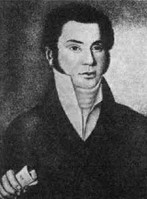
|
KOTLIAREVSKY, IVAN, b 9 September 1769 in Poltava, d 10 November 1838 in Poltava. Poet and playwright; the 'founder' of modern Ukrainian literature. After studying at the Poltava Theological Seminary (1780-9), he worked as a tutor at rural gentry estates, where he became acquainted with folk life and the peasant vernacular, and then served in the Russian army (1796-1808). He helped stage theatrical productions at the Poltava governor-general's residence and was the artistic director of the Poltava Free Theater (1812-21). Kotliarevsky's greatest literary work is his travesty of Virgil's Aeneid, Eneida, which he began writing in 1794. Publication of its first three parts in Saint Petersburg in 1798 was funded by Maksym Parpura. Part four appeared in 1809. Kotliarevsky finished parts five and six around 1820, but the first full edition of the work was published only after his death, in Kharkiv in 1842. Kotliarevsky's operetta Natalka Poltavka (Natalka from Poltava) and vaudeville Moskal'-charivnyk (The Muscovite-Sorcerer) were landmarks in the development of Ukrainian theater... |
| Ivan Kotliarevsky |
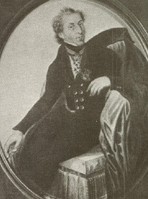
|
HULAK-ARTEMOVSKY, PETRO, b 27 January 1790 in Horodyshche (Cherkasy region), Kyiv gubernia, d 13 October 1865 in Kharkiv. Poet, fabulist, scholar and translator of classical literature. After studying at the Kyiv Theological Academy and Kharkiv University, in 1818 he was appointed lecturer of Polish at Kharkiv University, and in 1825, professor of Russian history and geography. From 1841 to 1849 he served as the university's rector. He began to publish in 1817. Familiar with the peasants' language and way of life, he wrote in the tradition of Ivan Kotliarevsky, using burlesque in his fables, supplications, poems, and travesties of Horace's odes. His best-known fable, 'Pan i sobaka' (The Master and His Dog, 1818), satirizes the arbitrary brutality of the serf-owning gentry. Some of his works, such as 'Do liubky' (To My Beloved), exhibit elements of sentimentalism. His Romantic ballads, 'Rybalka' (The Fisherman) and 'Tvardovs'kyi', are thematic borrowings from Johann von Goethe and Adam Mickiewicz supplemented with Ukrainian elements... |
| Petro Hulak-Artemovsky |
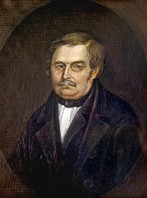
|
HOHOL-YANOVSKY, VASYL, b 1777 on the farmstead Kupchynskyi (today Hoholeve) near Myrhorod in the Poltava region, d March 1825 in nearby Kybyntsi. A landowner of Cossack starshyna descent and Ukrainian playwright; the father of Mykola Hohol (Nikolai Gogol). In the 1820s he directed the serf theater of the noble Dmytro Troshchynsky on the latter's estate in the village of Kybyntsi and wrote and staged several plays for it in Ukrainian. They include the intermede-like comedy 'Sobaka-vivtsia' (The Dog-Sheep) and the farce 'Prostak, ili khitrost' zhenshchiny, perekhitrennaia soldatom' (The Simpleton, or the Cunning of a Woman Outwitted by a Soldier), which is similar to Ivan Kotliarevsky's Moskal'-charivnyk (The Muscovite-Sorcerer)... |
| Vasyl Hohol-Yanovsky |
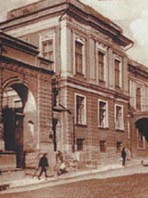
|
KHARKIV ROMANTIC SCHOOL. A group of young poets who were professors or students at Kharkiv University in the 1830s-1840s. The term 'school' was proposed by Ahapii Shamrai, who researched and published their poetry. The school's main representatives were Izmail Sreznevsky, Amvrosii Metlynsky, Mykola Kostomarov, Levko Borovykovsky, Mykhailo Petrenko, and Opanas Shpyhotsky. Like young poets of other nations in the Romantic period, they were imbued with an incipient national consciousness, which prompted them to study the ethnography of their people. While collecting, publishing, and imitating folk songs, legends, and stories, the Kharkiv romantics developed their own, predominantly historical, themes. As a result of their ethnographic interest, their view of the common people differed from the patronizing attitude of their predecessors Ivan Kotliarevsky and Hryhorii Kvitka-Osnovianenko. Instead of treating the people as naive children of nature, they saw in them a source of spiritual renewal and strength and poetic inspiration... |
| Kharkiv Romantic School |
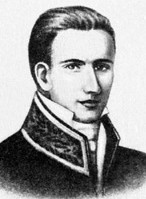
|
BOROVYKOVSKY, LEVKO, b 22 February 1806 in the village of Myliushky in Poltava gubernia, d 6 December 1889 in Myliushky. Romantic poet, writer, translator, and folklorist. After graduating in 1830 from Kharkiv University, Borovykovsky taught in a Kursk gymnasium and from 1839 in the Poltava Institute for Daughters of the Nobility. In 1852 he became a gymnasium inspector in Poltava gubernia and retired a few years later. His works were first published in 1828, and he was one of the first poets of the Kharkiv Romantic School. Of his numerous poems, the most notable is the ballad 'Marusia' (1829), a free reworking of Vasilii Zhukovsky's 'Svetlana.' During his lifetime only one collection of his writings was published which brought him recognition as a storyteller. He also translated the poetry of Horace, Aleksandr Pushkin, and Adam Mickiewicz, compiled a Ukrainian dictionary, and collected Ukrainian folklore. Borovykovsky's ballads and his contribution to the development of poetic vocabulary make him a precursor of Taras Shevchenko... |
| Levko Borovykovsky |
The preparation, editing, and display of the IEU entries featuring Ivan Kotliarevsky and the origins and modern Ukrainian literature were made possible by several individual donations made in memory of MARIA FEDAK of Toronto, Ontario, Canada.
 V. THE "RUTHENIAN TRIAD" AND WESTERN UKRAINIAN NATIONAL REVIVAL
V. THE "RUTHENIAN TRIAD" AND WESTERN UKRAINIAN NATIONAL REVIVAL
Although short-lived, a group of young Galician poets and scholars, established in the 1830s and known as the "Ruthenian Triad," played a decisive role in the Western Ukrainian cultural revival of the 19th century. Comprised by Markiian Shashkevych, Yakiv Holovatsky, and Ivan Vahylevych, the "Ruthenian Triad" united around itself other young people who began to research Ukrainian history and culture and actively promote the Ukrainian national cause. The members of the group maintained that the "Ruthenians" of Galicia, Bukovyna, and Transcarpathia were all part of one Ukrainian people who had their own language, culture, and history. The great importance of their literary collection, Rusalka Dnistrovaia (The Dniester Nymph, 1836), was in that it was written in the spoken Ukrainian and not in the "learned" yazychiie; it thus initiated the use of vernacular Ukrainian language for literature in the Ukrainian lands in the Habsburg Empire. Because of their populist and national views, the group members suffered harassment by the conservative Ukrainian clergy and Austrian authorities... Learn more about the legacy of the "Ruthenian Triad" and the origins of Western Ukrainian national revival by visiting the following entries:
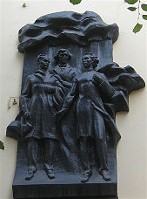
|
RUTHENIAN TRIAD (Ruska triitsia). A Galician literary group named after the number of the predominant members, Markiian Shashkevych, Yakiv Holovatsky, and Ivan Vahylevych, which existed in the late 1830s, while the three were students at the Greek Catholic Theological Seminary in Lviv. Since the group came into being during the period of Romanticism, it retained the predominant interests and features of that movement--an interest in folklore and history and a striving for Pan-Slavic unity. Its Slavophilism was noticeable in the use of Old Slavic pseudonyms: Ruslan by Shashkevych, Dalibor by Vahylevych, and Yaroslav by Holovatsky. The group founders as well as other young people united around them were engaged in collecting folk oral literature, studying the history of Ukraine, and writing their own verses and treatises. They emulated the Ukrainians under Russian rule, and were especially influenced by Ivan Kotliarevsky's Eneida (Aeneid)... |
| Ruthenian Triad |
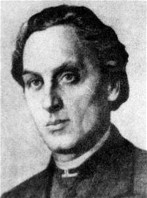
|
SHASHKEVYCH, MARKIIAN, b 6 November 1811 in Pidlyssia, Zolochiv circle, Galicia, d 7 June 1843 in Novosilky Lisni, now in Buzk raion, Lviv oblast. Poet and leader of the literary revival in Western Ukraine based on the vernacular. He graduated from the Greek Catholic Theological Seminary in Lviv in 1838 and worked as a priest in the rural Lviv region. During his studies he met Yakiv Holovatsky and Ivan Vahylevych, with whom he formed the Ruthenian Triad. He also organized nationally conscious Ukrainian young people to work for national and cultural revival in Western Ukrainian lands, particularly to reintroduce the use of spoken Ukrainian language in writing and sermons. Their efforts resulted in the preparation of collections of folklore and the publication of the almanac Rusalka Dnistrovaia (1836). The almanac had a decisive effect on the revival and development of Ukrainian literature in Galicia... |
| Markiian Shashkevych |
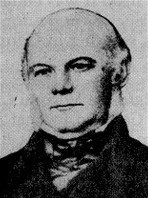
|
HOLOVATSKY, YAKIV, b 17 October 1814 in Chepeli, Zolochiv circle, Galicia, d 13 May 1888 in Vilnius. Noted historian, literary scholar, ethnographer, linguist, bibliographer, lexicographer, and poet. As a student he traversed Galicia, Bukovyna, and Transcarpathia collecting folk songs. In 1832, at Lviv University he, Markiian Shashkevych, and Ivan Vahylevych formed the Ruthenian Triad, which published the first Galician almanac in the vernacular, Rusalka Dnistrovaia (The Dniester Nymph, 1836), and played an important role in the Galician cultural revival. In 1843 he became a Greek-Catholic village priest. From 1848 to 1867 he was the first professor of Ruthenian (Ukrainian) philology at Lviv University. Influenced by Mikhail Pogodin's Pan-Slavist ideas, he became a Russophile in the 1850s. Dismissed from the university for his views, in 1867 he moved to Russian-ruled Vilnius to head the archeographic commission there... |
| Yakiv Holovatsky |
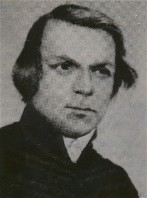
|
VAHYLEVYCH, IVAN, b 2 September 1811 in Yasen, Stanyslaviv circle, Galicia, d 10 May 1866 in Lviv. Romantic poet, philologist, and ethnographer of the Galician revival. While studying at Lviv University and at the Greek Catholic Theological Seminary in Lviv, he associated with Markiian Shashkevych and Yakiv Holovatsky, and the three of them formed the Ruthenian Triad. Because of his populist activities, cultural nationalist views, and correspondence with scholars in the Russian Empire, he suffered harassment by the church and Austrian civil authorities. During the Revolution of 1848-9 in the Habsburg monarchy he supported a democratic Polish-Ukrainian political federation. Later that year he left the Uniate church in protest against the church hierarchy's sanctions against him and converted to Lutheranism. Ostracized by most Ukrainians and by the church, he was unable to find steady work until 1862, when he was appointed city archivist in Lviv... |
| Ivan Vahylevych |
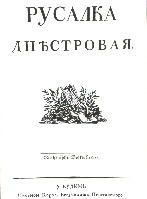
|
RUSALKA DNISTROVAIA (The Dniester Nymph). The first Ukrainian literary and folkloric almanac published in Galicia. It was compiled by the Ruthenian Triad (Markiian Shashkevych, Yakiv Holovatsky, and Ivan Vahylevych) and printed in Buda, Hungary, in December 1836. The almanac consisted of folk songs recorded in various places in Galicia, with an introduction by Vahylevych; poetry and prose by the Triad's members and their translations of Serbian folk poetry; texts of lyrical and heroic poetry from a 15th-century manuscript, with an introduction by Shashkevych; Holovatsky's note on manuscripts in the library of Saint Basil's Monastery in Lviv; and a review of a book of Ukrainian wedding rituals. In the manifesto-like preface Shashkevych stressed the beauty of the Ukrainian vernacular and folk oral literature and provided a list of the most important contemporary publications of literature and folklore in Russian-ruled Ukraine... |
| Rusalka Dnistrovaia |
The preparation, editing, and display of the IEU entries about the "Ruthenian Triad" and Western Ukrainian national revival were made possible by the financial support of the CANADIAN FOUNDATION FOR UKRAINIAN STUDIES.
 VI. TARAS SHEVCHENKO, PANTELEIMON
KULISH, AND UKRAINIAN ROMANTICISM
VI. TARAS SHEVCHENKO, PANTELEIMON
KULISH, AND UKRAINIAN ROMANTICISM
The first poets in the Ukrainian literature whose works were inspired by the Romantic current of the early 19th century were young scholars and students at Kharkiv University in the 1830s-1840s who formed the co-called Kharkiv Romantic School. Based on their deep interest in Ukrainian folklore, these poets developed new literary genres, translated and imitated works from other literatures, and wholly embraced Johann Gottfried von Herder's idea that Slavic folk poetry was closer to nature and less soiled by corrupt civilization than that of other peoples. However, in the 1840s Kyiv became the center of romanticism in Ukraine. It was at Kyiv University that the Cyril and Methodius Brotherhood emerged, which included, among others, Taras Shevchenko, Panteleimon Kulish, and Mykola Kostomarov. Unlike the Kharkiv Romantic School the brotherhood had a definite, if rather utopian, political and national program: it called for a Slavic federation and believed that Ukraine, where the Cossack traditions of freedom and democracy had flourished, would provide the leadership in the federation. Those ideas were incorporated into Knyhy bytiia ukrains'koho narodu (The Books of Genesis of the Ukrainian People), written by Kostomarov. Kostomarov also wrote drama on the Shakespearean model, philosophical poetry, literary criticism, and important historical studies. Another prominent member of the brotherhood, Panteleimon Kulish is noted primarily for his novel-chronicle Chorna rada (The Black Council, 1857), the first historical novel written in Ukrainian. Kulish was also a poet, a translator (of William Shakespeare, the Bible, George Byron, and other world classics), a literary critic, a prominent intellectual, a publisher, and a master of the Ukrainian language. As a poet, overshadowed by Taras Shevchenko but more conscious of his poetic role, Kulish experimented with language (the conscious introduction of Church Slavonic into the Ukrainian vernacular) and with poetic structure and versification (the attempt to domesticate various ancient and canonical strophes). But by far the greatest poet of that group was Taras Shevchenko. Unlike Kulish, Shevchenko was imbued with the Romantic spirit of revolt, and with him Ukrainian romanticism reached its pinnacle. He had the ability to express profound thought in seemingly simple words. With the appearance of his Kobzar (The Minstrel, 1840), and his 'Haidamaky' (The Haidamakas, 1841) Shevchenko dispelled all doubt as to whether the Ukrainian vernacular was suitable for a full-range literature. Shevchenko's poems consist of ballads, Byronic poems, social and political satire, didactic exhortations, and paraphrases of biblical texts. He was popular in his day, and his popularity continued to grow and with it the influence of his poetry. His stature grew to that of Ukraine's national poet... Learn more about Taras Shevchenko, Panteleimon Kulish, and the Ukrainian Romantic literature by visiting the following entries:
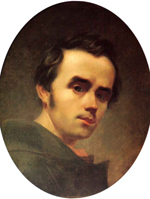
|
SHEVCHENKO, TARAS, b 9 March 1814 in Moryntsi, Zvenyhorod county, Kyiv gubernia, d 10 March 1861 in Saint Petersburg, Russia. Ukraine's national bard and famous artist. Born a serf, Shevchenko was orphaned when he was twelve and grew up in poverty. At the age of 14 he became a houseboy of his owner, P. Engelhardt, and served him in Vilnius (1828-31) and then Saint Petersburg. Engelhardt noticed Shevchenko's artistic talent, and in Saint Petersburg he apprenticed him to the painter V. Shiriaev. Shevchenko spent his free time sketching the statues in the capital's imperial summer gardens. There he met the Ukrainian artist Ivan Soshenko, who introduced him to other compatriots, such as Yevhen Hrebinka and Vasyl Hryhorovych. Through these men Shevchenko also met the famous painter and professor Karl Briullov, who donated his painting as the prize in a lottery whose proceeds were used to buy Shevchenko's freedom on 5 May 1838. Soon after, Shevchenko enrolled in the Imperial Academy of Arts and studied there under Briullov's supervision. In 1840 his first poetry collection, Kobzar, consisting of eight Romantic poems, was published in Saint Petersburg. It was followed by his epic poem Haidamaky (The Haidamakas, 1841) and the ballad Hamaliia (1844). After graduating from the academy of arts in 1845, Shevchenko became a member of the Kyiv Archeographic Commission and traveled widely through Russian-ruled Ukraine in 1845 to sketch historical and architectural monuments and collect folkloric materials. In 1844 and 1845, while he was in Ukraine, he wrote some of his most satirical and politically subversive narrative poems that contributed to Shevchenko's popularity but also made him a target of tsarist persecution... |
| Taras Shevchenko |
_s.jpg)
|
KULISH, PANTELEIMON, b 8 August 1819 in Voronizh, Chernihiv gubernia, d 14 February 1897 in Motronivka, Chernihiv gubernia. Prominent writer, poet, historian, ethnographer, translator, and intellectual. He was born into an impoverished Cossack-gentry family. In 1837 he enrolled at Kyiv University but was not allowed to finish his studies because he was not a noble. He obtained a teaching position in Lutsk in 1840. There he wrote his first historical novel in Russian Mykhailo Charnyshenko, or Little Russia Eighty Years Ago (2 vols, 1843). His first longer work written in Ukrainian was the epic poem 'Ukraina' (1843). In 1843-5 Kulish taught in Kyiv and studied Ukrainian history and ethnography. There he befriended Taras Shevchenko, Mykola Kostomarov, and Vasyl Bilozersky; their circle later became the nucleus of the secret Cyril and Methodius Brotherhood. In 1845 Kulish was invited to teach at Saint Petersburg University, where he finished in Ukrainian his major historical novel, Chorna rada, khronika 1663 roku (The Black Council, a Chronicle of the Year 1663). The Imperial Academy of Sciences granted him a scholarship to do research abroad. In 1847 he Kulish set out for Prague, but en route he was arrested by the tsarist police in Warsaw for belonging to the Cyril and Methodius Brotherhood, which had been uncovered at the time. After two months in prison he was exiled for three years to Tula. In 1850 he was allowed to return to Saint Petersburg. There he established a Ukrainian printing press and, after being allowed to publish under his own name, issued two splendid volumes of Zapiski o Iuzhnoi Rusi (Notes on Southern Rus', 1856-7), a rich collection of Ukrainian folklore, ethnography, and literature in which he introduced a new orthography (Kulishivka)... |
| Panteleimon Kulish |
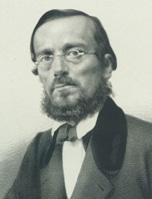
|
KOSTOMAROV, MYKOLA, b 16 May 1817 in Yurasivka, Ostrohozke county, Voronezh region, d 19 April 1885 in Saint Petersburg. Historian, publicist, and writer. In 1837 he graduated from Kharkiv University. From 1844 to 1845 Kostomarov taught history at the Rivne and at the First Kyiv gymnasiums. In 1846 he was appointed assistant professor in the Department of Russian History at Kyiv University. That year, along with Vasyl Bilozersky, Panteleimon Kulish, Mykola Hulak, Taras Shevchenko, and others, he formed the Cyril and Methodius Brotherhood. In Knyhy bytiia ukrains'koho narodu (Books of the Genesis of the Ukrainian People) and Ustav Slov'ians'koho tovarystva sv Kyryla i Metodiia: Holovni idei (The Statute of the Slavic Society of Saints Cyril and Methodius: Its Main Ideas), Kostomarov formulated the society's program and basic ideas: Christian piety, democratic republicanism, a Ukrainian national renaissance, Ukrainian messianism, and Pan-Slavic federalism. In 1847 he was arrested along with the other members of the society and sentenced to one year's imprisonment, followed by exile. Until 1856 he lived in Saratov. Three years later he moved to Saint Petersburg, where he was appointed to the Chair of Russian History at the university. Because of his political involvements he had to resign his university position in 1862. From then on he devoted himself exclusively to research. He wrote a number of fundamental works on the history of Ukraine in the 16th-18th centuries. In his studies Kostomarov argued for the national distinctiveness of the Ukrainian people and the uniqueness of their historial development, which, unlike for the Poles and Russians, was manifested in the Ukrainian freedom-loving, democratic, and individualistic spirit... |
| Mykola Kostomarov |
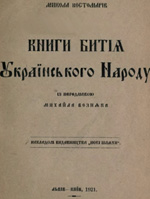
|
CYRIL AND METHODIUS BROTHERHOOD. Secret society established in December 1845-January 1846 in Kyiv at the initiative of Mykola Kostomarov. The aim of the society was to transform the social order according to the Christian principles of justice, freedom, equality, and brotherhood. It proposed a series of reforms: (1) abolition of serfdom and equality of rights for all estates, (2) equal opportunity for all Slavic nations to develop their national language and culture, (3) education for the broad masses of the people, and (4) unification of all Slavs in the spirit of the Slavophilism of the time in a federated state in which Ukraine would play a leading role. Kyiv was to be the capital of the federation and the seat of the all-Slavic diet. Among others, the following individuals belonged to the brotherhood: Kostomarov, Vasyl Bilozersky, Oleksander Navrotsky, Mykola Hulak, Dmytro Pylchykov, O. Petrov, Panteleimon Kulish, Opanas Markovych, Yurii Andruzky, Ivan Posiada, Mykola Savych, and Taras Shevchenko. The basic documents in which the ideas and program of the society are formulated are Knyhy bytiia ukrains'koho narodu (Books of the Genesis of the Ukrainian People) and Ustav Slov'ians'koho tovarystva sv Kyryla i Metodiia. Holovni idei (The Statute of the Slavic Society of SS Cyril and Methodius: Its Main Ideas), both written by Kostomarov, and a memorandum to the statute written by Vasyl Bilozersky. These documents and the society's activities were deeply influenced not only by the ideas of the Ukrainian renaissance of the first half of the 19th century, particularly by Istoriia Rusov (History of the Rus' People), but also by European romanticism. The Decembrist movement and Pan-Slavism also had some influence on the society's outlook... |
| Cyril and Methodius Brotherhood |
_s.jpg)
|
VOVCHOK, MARKO (pseud of Mariia Vilinska), b 22 December 1834 in Ekaterininskoe, Orel gubernia, Russia, d 10 August 1907 in Nalchik, Caucasia. Writer. In 1851 she married Opanas Markovych, who had been a member of the Cyril and Methodius Brotherhood, and moved from Orel to Ukraine. From 1851 to 1858 she lived in Chernihiv, Kyiv, and Nemyriv and studied the Ukrainian language and Ukrainian traditions and folklore and wrote Narodni opovidannia (Folk Stories), which was published in 1857. It met with immediate acclaim in Ukrainian literary circles, particularly from Taras Shevchenko and Panteleimon Kulish, and in Russia (it was translated into Russian and edited by Ivan Turgenev). In 1859, after a short stay in Saint Petersburg, Vovchok moved to Germany. She spent some time in Switzerland, England, and Italy but stayed the longest in Paris. In 1862 a two-volume edition of Narodni opovidannia was published, and individual works were published in journals in Russia and the Austrian-ruled Galicia. From 1867 to 1878 Vovchok lived in Saint Petersburg, where owing to the prohibition against the Ukrainian language she wrote and translated for Russian journals. From 1878 Vovchok lived in Subcaucasia, and in 1885-93 in Kyiv gubernia, where she continued her work on Ukrainian folklore and a dictionary. At the beginning of the 1900s she renewed her contact with Ukrainian publishers. Elements of realism appear mainly in her short stories about Ukrainian peasants living under serfdom and about the difficult plight of women. Other works continue the tradition of ethnographic romanticism and are typified by strong characters and willful heroes... |
| Marko Vovchok |
The preparation, editing, and display of the IEU entries about Taras Shevchenko, Panteleimon Kulish, and the Ukrainian Romantic literature were made possible by the financial support of the SENIOR CITIZENS HOME OF TARAS H. SHEVCHENKO (WINDSOR) INC. FUND at the Canadian Institute of Ukrainian Studies.
 VII. POPULIST WRITERS IN RUSSIAN-RULED UKRAINE (LATE 19th AND EARLY 20th CENTURY)
VII. POPULIST WRITERS IN RUSSIAN-RULED UKRAINE (LATE 19th AND EARLY 20th CENTURY)
Populist ideals, which began to crystallize in Russia and Ukraine following the Crimean War (1853-56) during the reign of Tsar Alexander II, had a profound impact on Ukrainian literature in the second half of the 19th century. Ukrainian and Russian populists idealized the people (narod), which, practically speaking, meant the peasantry. Russian populism, as ideology, was socially more radical and utopian than Ukrainian populism. Idealizing peasant traditions, especially communal farming, Russian populist thinkers believed that the peasant commune could serve as the foundation of a future socialist Russia. Ukrainian populists, generally known by their contemporaries as Ukrainophiles, were involved primarily in cultural and educational work. The main tenets of Ukrainian populism (narodnytstvo) were federalism, the emancipation of the peasantry, and the recognition of the cultural distinctiveness of the Ukrainian people. Study of the Cossacks induced romantic visions of rebellions against landlords and national oppressors and of the existence of a Cossack republic based on equality and brotherhood. Those ideas, reinforced by the fiery poetry of Taras Shevchenko, inspired a younger generation of Ukrainophiles, some of whom were also influenced by Western European utopian socialists. By the end of the 1870s the leading Ukrainian populist writers, Ivan Nechui-Levytsky and Panas Myrny, had written some of their most important works, and Ivan Franko had made his literary debut in Galicia. Despite the ban on the Ukrainian language in Russian-ruled Ukraine, Ukrainian literature had become established in its own right by the 1880s, that is, during the period when it was most evidently populist in orientation. Treating literary works as effective tools for propagating socio-political ideas, populist writers began to examine new, previously unexplored, themes in Ukrainian literature, such as the role of the intelligentsia and the women's question, in addition to the well-worn theme of the fate of poor village folk. To avoid censorship writers from Russian-ruled Ukraine published extensively in Galicia... Learn more about the legacy of Ukrainian populist writers in Russian-ruled Ukraine in the late 19th and early 20th century by visiting the following entries:
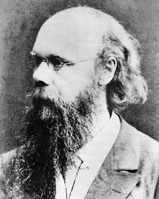
|
KONYSKY, OLEKSANDER, b 18 August 1836 at Perekhodivtsi khutir, Nizhyn county, Chernihiv gubernia, d 11 December 1900 in Kyiv. Writer, lawyer, scholar, and community leader. A leading member of the secret Poltava Hromada, he helped organize Sunday schools, prepared textbooks for them, and initiated the creation of the Poltava Literary Society. Much of his time was also devoted to Ukrainian-language publishing. He lived from 1866 in Katerynoslav and from 1872 until his death in Kyiv. As a member of the Kyiv city council, he tried to get Ukrainian introduced into the city's schools. One of the patrons of the Shevchenko Society in Lviv, he initiated its transformation into the Shevchenko Scientific Society in 1893 and bequeathed 10,000 rubles to it. As a writer, Konysky used over 100 pseudonyms. In his day his poetry (he was an epigone of Taras Shevchenko) was very popular. His more than 50 short stories and novelettes had more lasting value. They dealt with peasant life and tribulations and the social and national oppression of Ukraine. In some novelettes he depicted the problems encountered by the Ukrainophile intelligentsia. Konysky also wrote many literary studies, including a fundamental biography of Taras Shevchenko. In Soviet scholarship Konysky was denigrated as a 'nationalist,' and his works were not published from the late 1920s until 1986... |
| Oleksander Konysky |
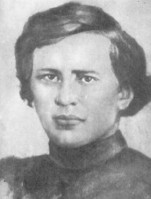
|
SVYDNYTSKY, ANATOLII, b 13 September 1834 in Mankivtsi, Lityn county, Podilia gubernia, d 18 July 1871 in Kyiv. Writer, community activist, and folklorist. He began his activities as a member of the clandestine Kharkiv-Kyiv Secret Society, which set itself the task of struggling with the tsarist regime, disseminating forbidden literature, and establishing Sunday schools. During that period he wrote a number of lyric poems against arbitrary rule and national oppression. After the tsarist ban of all Ukrainian publications he published a number of articles and stories in Russian in the newspaper Kievlianin. The novel Liuboratski is considered to be Svydnytsky's major work. It is a chronicle, to a large extent autobiographical, of the downfall of the Liuboratsky family of clergymen over the course of three generations. It is set in the Podilia region, which was dominated by the Polish aristocracy, tsarist oppression, and the inimical official Orthodox clergy. Its far-reaching range of subject matter prompted Ivan Franko to designate the work as the first realist novel in Ukrainian literature. In both form and content Liuboratski serves as a transition between the prose of Hryhorii Kvitka-Osnovianenko and Marko Vovchok and the later epic realism of Ivan Nechui-Levytsky and Panas Myrny. However, the novel had no immediate influence on contemporary writers because it was published for the first time only in 1886, 15 years after the author's death... |
| Anatolii Svydnytsky |
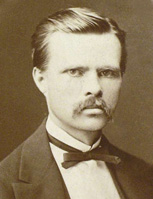
|
NECHUI-LEVYTSKY, IVAN, b 25 November 1838 in Stebliv, Kaniv county, Kyiv gubernia, d 15 April 1918 in Kyiv. Writer. Upon graduating from the Kyiv Theological Academy (1865) he taught Russian language, history, and geography in gymnasiums in various cities. He began writing in 1865, but because of Russian imperial censorship his works appeared only in Galician periodicals. He mainly wrote stories, in which he combined the styles of the novel and the folkloric narrative. His works about the lives of peasants and laborers established him as a master of Ukrainian classical prose and as the creator of the Ukrainian realist narrative. Nechui-Levytsky was the first to provide fictional characterizations of various classes of the Ukrainian intelligentsia, ranging from students and teachers to high-ranking members of the Russian civil service. Against a background of colonial repression and thoroughgoing Russification Nechui-Levytsky sought to depict the stirrings of national consciousness in the Ukrainian intelligentsia and their attempts to 'place first on the agenda the inevitability of national liberation.' Such is the theme of Khmary (Clouds, 1874), the first Ukrainian work of fiction to address this problem. In his numerous articles on Ukrainian theater and Ukrainian literature Nechui-Levytsky championed the idea of a national culture formed independently of outside influences, and asserted that 'Russian literature is useless [as a model] for Ukraine'... |
| Ivan Nechui-Levytsky |
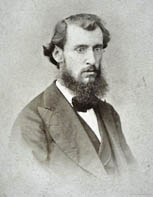
|
MYRNY, PANAS (pseudonym of Panas Rudchenko), b 13 May 1849 in Myrhorod, d 28 January 1920 in Poltava. Writer. The works of Taras Shevchenko had the greatest influence on the formation of Myrny's worldview, artistic preferences, and ideology. His early literary attempts included poems, dramas, and short stories. His best-known work is the novel Propashcha syla (The Ruined Strength), also titled Khiba revut' voly, iak iasla povni? (Do the Oxen Bellow, When Their Mangers Are Full?, 1880). The work can be characterized as a sociopsychological novel-chronicle; it covers almost a hundred years in the history of a Ukrainian village, from serfdom to the postreform era. In it Myrny depicts social oppression, internal strife between different social groups, the tsarist legal system, the harsh life of soldiers, police violence, and spontaneous protests against lies and injustice. Myrny's second important sociopsychological novel, Poviia (Loose Woman, 1884), describes new social processes brought about by the reforms of 1861. Myrny also wrote some dramatic works and his most popular drama was Lymerivna (The Daughter of the Harness Maker, 1883). He is also known as the translator of Henry Wadsworth Longfellow's poem The Song of Hiawatha and of William Shakespeare's King Lear into Ukrainian. Myrny markedly expanded the lexicon of the literary Ukrainian language and with his talent for rhythmic and melodious phrasing enriched Ukrainian syntax... |
| Panas Myrny |
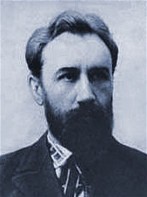
|
HRINCHENKO, BORYS, b 9 December 1863 at Vilkhovyi Yar khutir in Kharkiv county, d 6 May 1910 in Ospedaletti, Italy. Prominent public figure, writer, folklorist, and linguist. In 1894 he settled in Chernihiv, where he organized the largest publishing house in Russian-ruled Ukraine, which published 50 popular-educational books despite severe censorship. In 1902 he moved to Kyiv. His dedicated service to the populist cause began in the 1880s when the prospects of success appeared dimmest. It consisted mostly of journalistic and community work aimed at shaping, in Hrinchenko's words, 'out of the Ukrainian nation one nationally conscious, enlightened community' that would have access to all the achievements of culture and would overcome the gap between the common people and the intelligentsia. Hrinchenko's literary work was directly linked with his journalistic writings. In his realistic short stories and novelettes he depicted Ukrainian peasant life while raising urgent social questions, the attitude of the intelligentsia to the peasantry, the education and denationalization of the rural population. Hrinchenko was also a noted Ukrainian ethnographer. His interest in ethnography led him to collect material for the 68,000-word, four-volume dictionary of the Ukrainian language (1907-9) that he edited. Until mid twentieth century this dictionary was the fullest Ukrainian dictionary of its kind... |
| Borys Hrinchenko |
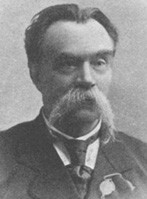
|
STARYTSKY, MYKHAILO, b 14 December 1840 in Klishchyntsi, Zolotonosha county, Poltava gubernia, d 27 April 1904 in Kyiv. Writer and theatrical and cultural activist. Orphaned in childhood, Starytsky was raised by his uncle, the father of Mykola Lysenko. He studied at the Poltava gymnasium (until 1856), Kharkiv University (1858-60), and Kyiv University (1860-6). From 1867 he lived in Kyiv and worked with Lysenko; he wrote librettos for many of Lysenko's operas. Owing to official tsarist hostility to his work after the Ems Ukase was introduced, Starytsky was forced to emigrate in 1878 and live abroad for some time. He returned to Ukraine in 1880 and resumed his publishing activities and theater work. In 1883 he headed the first Ukrainian professional theater. In 1885 he founded a new troupe with young actors. Starytsky was first published in 1865. An important part of his literary legacy is his poetry on social issues, which is characterized by populist and patriotic motifs, glorification of the Ukrainian past, and protests against tsarism. He also made a considerable contribution to Ukrainian theater and dramaturgy. His most notable plays are his social dramas and the play Oi ne khody, Hrytsiu, ta i na vechornytsi (Don't Go to Parties, Hryts!, 1892) that became very popular. His later historical dramas merit particular attention. During the last years of his life Starytsky wrote several historical novels on Ukrainian themes in Russian and Ukrainian... |
| Mykhailo Starytsky |
The preparation, editing, and display of the IEU entries featuring the legacy of Ukrainian populist writers in Russian-ruled Ukraine in the late 19th and early 20th century were made possible by the financial support of the CANADIAN FOUNDATION FOR UKRAINIAN STUDIES.
 VIII. IVAN FRANKO AND THE WESTERN UKRAINIAN POPULISTS AND RADICALS
VIII. IVAN FRANKO AND THE WESTERN UKRAINIAN POPULISTS AND RADICALS
Like Taras Shevchenko, Ivan Franko is considered one of Ukraine's most important literary figures. A very prolific writer, poet, publicist, and important political leader, Franko exerted a tremendous influence not only on his native Western Ukraine, but on the Ukrainian culture and national consciousness as a whole. In the last decades of the 19th-century and the first decades of the 20th-century he played a key role in the shaping of the powerful Western Ukrainian populist movement and the formation of Ukrainian radicalism. Although he was an ardent proponent of the realist style in literature and art and was consistently critical of modernist trends, Franko himself did not remain immune to new literary currents and produced (in such collections as Withered Leaves, 1896) one of the first modernist poems in Western Ukraine. Learn more about Ivan Franko and his environment by visiting the following entries:
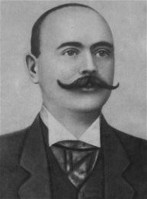
|
MARTOVYCH, LES, b 12 February 1871 in Torhovytsia, Horodenka county, Galicia, d 11 January 1916 in Poharysko, Rava-Ruska county, Galicia. Writer, lawyer, and community activist. He completed his legal studies by correspondence at Lviv University in 1909 and worked as a clerk and legal assistant in various Galician towns. From 1898 he lived in Lviv and edited the radical newspaper Hromads'kyi holos. His first published work appeared in 1889, a story entitled 'Nechytal'nyk' (The Illiterate). He later published collections of stories and the novellette Zabobon (Superstition, 1917). He depicted the daily life of the Galician peasantry and small-town intelligentsia, particularly that of priests and teachers of the late 19th and early 20th centuries. He wrote in the realist style, with touches of impressionism and with occasional sharp satire directed at the rural bourgeoisie and the bureaucracy. He contributed to Dilo and other newspapers and journals. His works were translated many times, and a three-volume compilation of his works, edited by Yurii Hamorak, was published in 1943. Other editions of selected works have appeared in Ukraine since 1949... |
| Les Martovych |
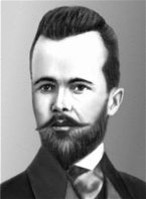
|
CHEREMSHYNA, MARKO (pseudonym of Ivan Semaniuk), b 13 June 1874 in Kobaky, Kosiv county, Galicia, d 25 April 1927 in Kobaky; buried in Sniatyn, Galicia. Writer. Cheremshyna completed a law degree at the University of Vienna in 1906 and maintained a law practice in Sniatyn, where he was active in civic life. He began writing short stories as early as 1896 and published them in newspapers and journals. On the basis of regional origin, Cheremshyna is often placed together with Vasyl Stefanyk and Les Martovych in the 'Pokutia triad.' Yet Cheremshyna's stories are more like chronicles of local peasant life and lack the tension and force of Stefanyk's works, as well as the humor and satire of Martovych's. They reflect the dialectal traits of Pokutia and are marked by a rhythm and style reminiscent of folk laments or of folk epics. Two collections of his stories appeared during his lifetime. These have been followed posthumously by many selected and collected works, published in Galicia and in the Ukrainian SSR, including his last collection Verkhovyna (Highlands, 1929). Cheremshyna was also known for his translations of short stories from German, Czech, and Hungarian. In 1949 the Cheremshyna literary memorial museum was founded in Sniatyn... |
| Marko Cheremshyna |
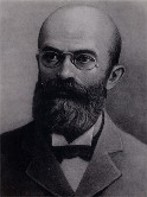
|
PAVLYK, MYKHAILO, b 17 September 1853 in Monastyrske (now part of Kosiv), Kolomyia circle, Galicia, d 26 January 1915 in Lviv. Galician socialist figure and publicist; full member of the Shevchenko Scientific Society from 1900. He and Ivan Franko became close friends as students at Lviv University. Both of them contributed to the Academic Circle's organ, Druh (1874-7), and both became Ukrainophile socialists under the influence of Mykhailo Drahomanov's letters to Druh and the Polish-language newspaper Praca. Through his writings Pavlyk remained the principal Galician propagator of Drahomanov's ideas, which brought about his persecution (he was tried in court nearly 30 times), imprisonment (in 1877, 1878, 1882, 1885-6, and 1889), and ostracism. With Franko he edited (1878) the socialist journal Hromads'kyi druh and miscellanies Dzvin and Molot, all of which outraged the conservative Galician public and were confiscated by the police... |
| Mykhailo Pavlyk |
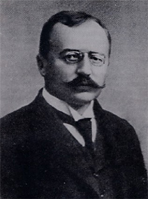
|
MAKOVEI, OSYP, b 23 August 1867 in Yavoriv, Galicia, d 21 August 1925 in Zalishchyky. Writer, journalist, and teacher. He attended Lviv University, from which he graduated in 1893. Varied work as an editorial assistant and a contributor to Dilo (1891), Narodna chasopys' (1892), and other newspapers prepared him for the position of editor of Bukovyna (1895-7). He was also one of the editors of Literaturno-naukovyi vistnyk (1897-9)... |
| Osyp Makovei |
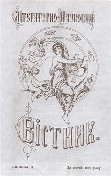
|
LITERATURNO-NAUKOVYI VISTNYK (Literary Scientific Herald, or LNV). A monthly journal published in 1898-1906 in Lviv, in 1907-14 and 1917-19 in Kyiv, and in 1922-32 again in Lviv. It was founded on the initiative of Mykhailo Hrushevsky as the organ of the Shevchenko Scientific Society (NTSh), incorporating the journals Zoria (published by the NTSh) and Zhytie i slovo (published by O. Franko). LNV became the foremost literary-scientific journal of the day. The editorial board consisted of Mykhailo Hrushevsky (editor in chief), Ivan Franko, Oleksander Borkovsky, and Osyp Makovei... |
| Literaturno-naukovyi vistnyk |
The preparation, editing, and display of the IEU entries associated with Ivan Franko and Western Ukrainian populist and radical movements were made possible by the financial support of the CANADIAN FOUNDATION FOR UKRAINIAN STUDIES.
 IX. UKRAINIAN MODERNIST WRITERS OF THE LATE 19TH AND EARLY 20TH CENTURY
IX. UKRAINIAN MODERNIST WRITERS OF THE LATE 19TH AND EARLY 20TH CENTURY
Toward the end of the 19th century the dominant realist style in Ukrainian literature began to give way to various trends of modernism, an international movement in literature and art that emphasized the sense of a radical break with the past and the possibility of a transformed world. Inspired by new works of Western European literatures, some Ukrainian writers no longer aimed for a naturalistic 'copy' of reality, and instead elected impressionist, symbolist, or expressionist modes of writing. Their focus was on subjective perceptions and on the inner psychological conflicts of complex personalities, often belonging to the educated urban intelligentsia. Along with these changes of themes longer realist prose works (novels and novelettes) gave way to lyrical or impressionist short stories. In drama the action passed inward, to explore the psychological conflicts, moods, and experiences of the characters. Poetry abandoned its realistic and didactic orientation in favor of the symbolic; emphasis on content gave way to a fascination with form. The work of Mykhailo Kotsiubynsky marks the transition from realism to modernism in the Ukrainian prose. Olha Kobylianska, a woman writer contemporary of Kotsiubynsky, was not so much an impressionist in her manner as a neoromantic. The neoromantic tendency in modernism also prompted a particular rekindling of interest in folklore and resulted in the appearance of a number of remarkable works of literature, including Lesia Ukrainka's play Lisova pisnia (The Song of the Forest, 1911). The master of the very short expressionist story focused on the lives of the peasants was Vasyl Stefanyk. The novelist and dramatist Volodymyr Vynnychenko was deeply interested in the psychological experiences and especially the morality of the intelligentsia. One of the first modernists among Ukrainian poets, Mykola Vorony, consciously opposed the realist and folkloric poetry and introduced the motifs of the city, a subjective mood, and the 'cult of beauty'... Learn more about the Ukrainian modernist writers of the late 19th and early 20th century by visiting the following entries:
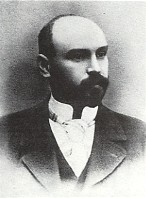
|
MYKHAILO KOTSIUBYNSKY, b 17 September 1864 in Vinnytsia, d 25 April 1913 in Kyiv. One of the finest Ukrainian writers of the late 19th and early 20th centuries. Expelled from the Kamianets-Podilskyi Theological Seminary in 1882 for his populist involvement, he remained under police surveillance for the rest of his life. His reading of the works of Ludwig Feuerbach and Charles Fourier contributed to his becoming an atheist and a socialist, and Ukrainian literature awakened in him a national consciousness and a desire to work for his people at an early age. In 1892-7 he was a member of the secret Brotherhood of Taras. Kotsiubynsky's earliest stories are examples of ethnographic realism, but in the late 1890s his themes and subjects became more varied and his approach more sophisticated, and he evolved into one of the most talented Ukrainian modernist writers. His most artistic works are 'Intermezzo' (1908), in which he depicted, using a combination of naturalism and impressionism, the healing powers of nature for a neurasthenic author; and Tini zabutykh predkiv (The Shadows of Forgotten Ancestors, 1911), a psychological novella about Hutsul life that draws widely on pagan demonology and folk legends. His masterfully written, linguistically sophisticated works had a great influence on early-20th-century Ukrainian prose writers and poets (eg, Pavlo Tychyna)... |
| Mykhailo Kotsiubynsky |
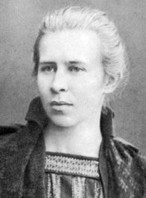
|
LESIA UKRAINKA (pseudonym of Larysa Kosach-Kvitka), b 25 February 1871 in Zviahel, Volhynia, d 1 August 1913 in Surami, Georgia. Poet and playwright. Lesia Ukrainka achieved a broad education by self-tuition and knew all of the major Western European languages as well as Greek and Latin and the Slavic languages. She began writing poetry at a very early age, and she wrote more prolifically from the mid-1880s. Her first collection of original poetry, Na krylakh pisen' (On Wings of Songs), appeared in 1893. However, she reached her literary heights in her poetic dramas. Ukrainka's first drama Blakytna troianda (The Azure Rose, 1896) describes the life of the Ukrainian intelligentsia. In further dramatic works she developed a new genre for the Ukrainian literature, that of the 'dramatic poem.' Particularly notable are her dramatic poems on the subject of prisoners in Babylon, the destruction of Troy, or the deeds of early Christians, which were meant to serve, among others, as symbols of the fate of Ukraine and the imprisonment of Ukrainians within the Russian Empire. Her neoromantic drama Lisova pisnia (The Song of the Forest) treats the conflict between lofty idealism and the mundane demands of everyday life. Ukrainka also wrote prose works. Her literary legacy is very extensive, despite the fact that for most of her life she was ill and often was bedridden for months... |
| Lesia Ukrainka |
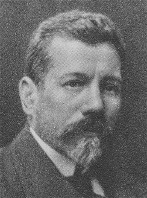
|
VASYL STEFANYK, b 14 May 1871 in Rusiv, Galicia, d 7 December 1936 in Rusiv. Prose writer. In the course of his early studies Stefanyk became aquainted with Les Martovych and Lev Bachynsky, both of whom had an influence on his life: Martovych turned him to writing, and Bachynsky steered him toward community-political involvement. Later, while he was a student at Cracow University, Stefanyk was befriended by the Polish doctor Waclaw Moraczewski and his wife, Sofiia Okunevska-Moraczewska, who aquainted him with contemporary European culture and literature and with the members of the Polish modernist group Mloda Polska. His first attempts to publish his introspective poetic prose were rejected by Ukrainian newspapers, but finally his first collection of novellas, Synia knyzhechka (The Blue Book), was published in 1899. With its appearance came immediate literary acclaim, and his stories were translated into Polish and other languages. However, discouraged by the criticism of the conservative Ukrainian public, Stefanyk fell silent and returned to literature only after 1916. His entire literary output consisted of 59 published novellas, most of them no longer than a couple of pages. In them he showed himself a master of the short story genre, characterized by a succinct and highly dramatic form used to capture single crucial moments in the life of a hero... |
| Vasyl Stefanyk |
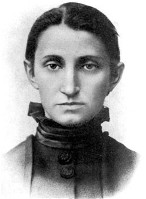
|
OLHA KOBYLIANSKA, b 27 November 1863 in Gura Humorului, Bukovyna, d 21 March 1942 in Chernivtsi. A pioneering Ukrainian modernist writer. A self-educated and well-read woman, her first novellen were written in German, beginning in 1880. Her travels and acquaintance with Lesia Ukrainka, Nataliia Kobrynska, Osyp Makovei, Ivan Franko, Vasyl Stefanyk, and Mykhailo Kotsiubynsky changed her cultural and political outlook, and she became involved in the Ukrainian women's movement in Bukovyna and began writing in Ukrainian. Many of her works--including the novels Liudyna (A Person, 1891) and Tsarivna (The Princess, 1895)--have as their protagonists cultured, emancipated women oppressed in a philistine, provincial society; semiautobiographical elements and the influence of the writings of George Sand and Friedrich Nietzsche are evident. A neoromantic symbolist, she depicted the struggle between good and evil and the mystical force of nature (eg, the short story 'Bytva' [Battle]), predestination, magic, and the irrational in many of her stories of peasant life and in her most famous novels, Zemlia (Land, 1902) and V nediliu rano zillia kopala (On Sunday Morning She Gathered Herbs, 1909). Her works are known for their impressionistic, lyrical descriptions of nature and subtle psychological portrayals... |
| Olha Kobylianska |
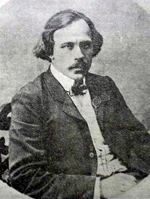
|
VORONY, MYKOLA, b 7 December 1871 in Rostov-na-Donu, Oblast of the Don Cossack Host, d (executed) 7 June 1938 in Odesa. Poet, journalist, and theater director. He studied at the Kharkiv and Rostov pedagogical institutes, but his studies were interrupted by
his arrest for political activity. He remained under tsarist police surveillance for three years and then emigrated to study in Vienna and Lviv. In 1897 he returned to Russian-ruled Ukraine, acted in the troupes of Marko Kropyvnytsky and Panas Saksahansky, and joined the Revolutionary Ukrainian party. Vorony began writing poetry while he was still a student. He was one of the first Ukrainian modernists; his modernist manifesto of 1901 provoked a lively discussion. The almanac Z-nad khmar i z dolyn (From Above the Clouds and from the Valleys, 1903), edited by Vorony, was the first programmatically modernist literary collection published in Ukraine. In 1920-1 Vorony was a senior attache with the Government-in-exile of the Ukrainian National Republic in Warsaw. He emigrated to Soviet Ukraine in 1926, taught at the Kharkiv Music and Drama Institute, and worked as a screenwriter, critic, and translator in Kyiv. In 1934 Vorony was arrested by the NKVD and exiled for three years to Voronezh. He was rearrested in 1938 and sentenced to death by firing squad... |
| Mykola Vorony |
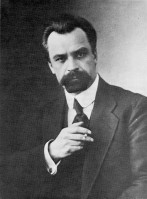
|
VOLODYMYR VYNNYCHENKO, b 27 July 1880 in Velykyi Kut, Kherson gubernia, d 6 March 1951 in Mougins, France. Writer, statesman, and politician. Vynnychenko began to study law at Kyiv University in 1901 but, owing to his expulsion in 1902 for 'revolutionary' activities, he never completed his studies. He was a member of the executive committee of the Ukrainian Social Democratic Workers' party. In 1917 he was chosen one of two vice-presidents of the Central Rada and then the first president of the General Secretariat, the autonomous government of Ukraine. Upon disagreeing with the politics of the Directory of the Ukrainian National Republic Vynnychenko left for Vienna and finally settled in France where he devoted himself almost exclusively to his literary career. He began writing while he was a student, during which time he produced stories depicting the working-class milieu. In both his heroes and his themes he abandoned the former populist didactic piety for the more risque contemporary revolutionary life, which is often tinged with explicit sexual tensions and wry humor. His short stories were extremely popular as a result. In the 20 plays he wrote (many of them translated and staged in various theaters of Europe) he examined closely the frequent disparity between deed and 'noble word,' aim and moral code of the revolutionaties of his time... |
| Volodymyr Vynnychenko |
The preparation, editing, and display of the IEU entries associated with the Ukrainian modernist writers of the late 19th and early 20th century were made possible by the financial support of the SENIOR CITIZENS HOME OF TARAS H. SHEVCHENKO (WINDSOR) INC. FUND at the Canadian Institute of Ukrainian Studies.
 X. THE MOLODA MUZA AND UKRAINIAN MODERNIST LITERATURE IN WESTERN UKRAINE
X. THE MOLODA MUZA AND UKRAINIAN MODERNIST LITERATURE IN WESTERN UKRAINE
Toward the end of the 19th century realism in Ukrainian literature started to give way to modernism. Emerging as a rejection of populism, Ukrainian literary modernism championed the idea of creating 'pure art' in the vein of Western European literature of the time. The Lviv-based Moloda Muza group (in Western Ukraine) and the Kyiv-based journal Ukrains'ka khata (in Russian-ruled Ukraine) believed that the necessary modernization of Ukrainian literature required a change in thematic focus from the social to the psychological and the greater sophistication of literary form. The most prominent members of the Moloda Muza were the poets Petro Karmansky, with his end-of-the-century pessimism, and Vasyl Pachovsky, remarkable for his formal diversity. Some members of the group were influenced by its Polish counterpart Mloda Polska. But though they were much less radical than their Polish 'modernist' friends, to say nothing of the Western European symbolists and decadents whose works they often translated, the members of Moloda Muza not only did not receive popular support (their ambitious magazine S'vit had to give up its international profile and turn to more mundane matters after only nine months of publication), they had to contend with attacks from such notables as Serhii Yefremov and Ivan Franko. Franko's criticism, despite his sensitivity to their talent, centered on the absence of proper and meaningful purpose in their creativity. At a time when so much still had to be done in the social, national, and political spheres, there was, according to Franko, little room for the luxury of esthetics. The group members' sensitive brooding was labeled destructive pessimism, their attention to form, needless formalism, and their striking imagery, decadence... Learn more about the Moloda Muza group and modernist literature in Western Ukraine by visiting the following entries:
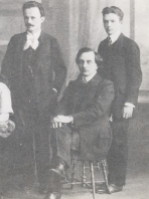
|
MOLODA MUZA. An informal modernist group of writers and artists in Western Ukraine, founded in 1906. The group's manifesto, as expressed by one of the founders (Ostap Lutsky), was 'freedom and liberty in content and form' and an emphasis on the more subtle and gentle experiences of the human soul. The group established a publishing house with the same name, which during its brief existence (1906-9) brought out more than 10 books and the extremely ambitious but short-lived magazine S'vit. The members consisted of the writers Bohdan Lepky, Vasyl Pachovsky, Petro Karmansky, Mykhailo Yatskiv, Stepan Charnetsky, Ostap Lutsky, Sydir Tverdokhlib, and Volodymyr Birchak, the painter Modest Sosenko, the sculptor Mykhailo Parashchuk, and the composer Stanyslav Liudkevych. Although the style and quality of their literary production is varied and uneven, some common traits which characterize the group as a whole include a predilection for the esthetic above the utilitarian in life and an affinity for the pessimism of the Western European intelligentsia of the turn of the century... |
| Moloda Muza |
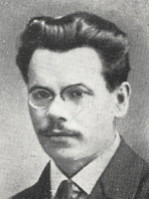
|
KARMANSKY, PETRO, b 29 May 1878 in Chesaniv, Galicia, d 16 April 1956 in Lviv. Poet, civic leader, and journalist. Karmansky was a prominent member of the modernist group Moloda Muza, and his early poetry, starting with the collection Z teky samovbyvtsia (From the Briefcase of a Suicide, 1899), reflect the typical fin-de-siecle ennui and pessimism of the modernist poets throughout Europe. His particular idiom is characterized by the frequent use of religious imagery and the often satiric tone provoked by the estrangement between the brooding modernist poet and 'callous' society. Discontent did not leave him even when he tried to work within the needs of the society by being a high-school teacher, then a representative in the diplomatic missions of the Western Ukrainian National Republic to Rome, the United States, Canada, and Brazil, and finally an editor (1922-5). After the Soviet occupation of Western Ukraine, Karmansky lectured at Lviv University and wrote two collections distinguished by their official optimism... |
| Petro Karmansky |
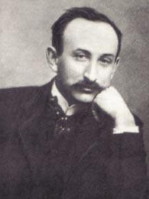
|
YATSKIV, MYKHAILO, b 5 October 1873 in Lesivka, Stanyslaviv county, Galicia, d 9 December 1961 in Lviv. Writer; member of the modernist group Moloda Muza. Yatskiv began his literary career in 1900 with a collection of prose miniatures, V tsarstvi satany (In the Kingdom of Satans), which was influenced by Western modernists, and in particular Charles Baudelaire and Edgar Allan Poe and their predilection for the 'darker' elements in life. Yatskiv transformed these motifs into naturalistic sketches of the brutality of life. Besides other collections of miniatures and short stories (which constitute Yatskiv's most important literary achievement), he also wrote the novelette Ohni horiat' (Fires Are Burning, 1902) and the novel Tanets' tinei (Dance of Shadows, 1916-7). In 1921 Yatskiv edited the newspaper Ridnyi krai in Lviv, and after the Soviet takeover of Western Ukraine he worked in the Lviv Library of the AN URSR. A volume of his collected works, Muza na chornomu koni (Muse on a Black Horse), appeared in 1989... |
| Mykhailo Yatskiv |
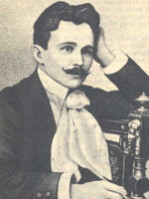
|
PACHOVSKY, VASYL, b 12 January 1878 in Zhulychi, Zolochiv county, Galicia, d 5 April 1942 in Lviv. Poet, dramatist, publicist, and teacher. Pachovsky studied at Lviv University (medicine) and Vienna University (history) and completed his studies with a teacher's certificate in 1909. He worked as a cultural representative of the Union for the Liberation of Ukraine in the internment camp at Knittelfeld, Austria (1914-15), edited Strilets' (1918-19) while serving in the Ukrainian Galician Army. Pachovsky was a prominent member of Moloda Muza and made his literary debut in 1901 with a collection of lyric poetry, Rozsypani perly (Scattered Pearls). His poetry is marked by a highly melodic line and folk-song stylizations. His dramas, written more in the modernist manner as highly lyrical allegories, at times too publicistic, are stylized patriotic visions of Ukraine in its quest for freedom. Similar in style to his plays is Pachovsky's epic poem, Zoloti vorota (The Golden Gates), of which only two of the projected four volumes were finished... |
| Vasyl Pachovsky |
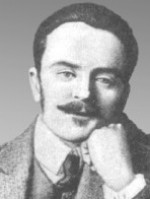
|
LEPKY, BOHDAN, b 4 November 1872 in Krehulets, Husiatyn county, Galicia, d 21 July 1941 in Cracow. Galician writer, literary scholar, civic figure, and artist. Lepky studied at Lviv University, the University of Vienna, and Cracow University and then taught in gymnasiums in Berezhany (1895-9) and at Cracow University (1899-1941). His home in Cracow was a well-known meeting place for Ukrainian writers, artists, and scholars. In 1906 he became a founding member of the Moloda Muza writers' group. Some of his poems were put to music by Ukrainian composers; the requiem song Zhuravli (Cranes) is the most famous of them. From 1898 to 1911 over a dozen collections of Lepky's realistic stories and impressionist prose poems appeared. Between the years 1901 and 1920 he also published over 15 collections of predominantly neoromantic and lyrical (elegiac and introspective) but also social and patriotic poetry. After the First World War Lepky turned to writing historical novels, such as the (unfortunately esthetically uneven) Ukrainian historical prose epic Mazepa... |
| Bohdan Lepky |
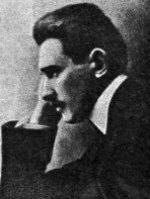
|
CHARNETSKY, STEPAN, b 21 January 1881 in Shmankivtsi, Chortkiv county, Galicia, d 2 October 1944 in Lviv. Poet, feuilleton writer, theatrical producer and director, drama critic, and a member of the Moloda Muza writers' group. In 1913-14 he was in charge of the Ruska Besida Theater in Lviv. He co-edited (in 1916-18) the daily Ukrains'ke slovo (1915-18) and then the weekly Ukrains'ke slovo (1922-5) and wrote feuilletons under the pseudonym Tyberii Horobets. He published several collections of modernist lyrical poetry in which he expressed moods of melancholy and unease as well as his affinity for the decadent literature of Central and Western Europe of the turn of the century. His short stories and feuilletons appeared in several collections and in the posthumous, abbreviated edition Vybrane (Selections, 1959). Charnetsky also translated Polish and German literary works and wrote a short history of the Ukrainian theater in Galicia (1934)... |
| Stepan Charnetsky |
The preparation, editing, and display of the IEU entries about the Moloda Muza group and the Ukrainian modernist literature in Western Ukraine were made possible by the financial support of the CANADIAN FOUNDATION FOR UKRAINIAN STUDIES.
 XI. MYKOLA KHVYLOVY, VAPLITE, AND THE UKRAINIAN CULTURAL RENAISSANCE OF THE 1920s
XI. MYKOLA KHVYLOVY, VAPLITE, AND THE UKRAINIAN CULTURAL RENAISSANCE OF THE 1920s
The downfall of the Russian Empire after the First World War, the resulting abolition of imperial censorship, the establishment of an independent Ukrainian state (even if for a very short time), and the relative leniency of the Soviet regime in the 1920s all led to an astonishing renaissance of literary and cultural activity in Ukraine. Scores of new writers and poets appeared and formed dozens of literary groups that changed the face of Ukrainian literature. Perhaps the most charismatic cultural leader was Mykola Khvylovy, a prominent writer, publicist, and founder of the elitist literary organization Vaplite. Among Vaplite's members were a renowned playwright Mykola Kulish, a brilliant symbolist poet Pavlo Tychyna, an avant-garde poet and writer Maik Yohansen, and such accomplished writers and poets as Yurii Yanovsky, Arkadii Liubchenko, and Mykola Bazhan. However, the Ukrainian cultural renaissance of the 1920s was brutally quashed by Stalinist terror of the 1930s. As a symbolic act of defiance and concern for his nation in the face of the man-made Famine-Genocide of 1932-3 and the growing campaign of political terror, Khvylovy committed suicide in May 1933. The vast majority of Vaplite members, including Kulish and Yohansen, were imprisoned and many were of them executed. Others, including Tychyna, were forced to capitulate to the Soviet regime and begin producing works in the socialist-realist style which glorified Joseph Stalin and the Communist Party. Nonetheless, in a very brief time of relative creative freedom, these writers managed to create a remarkable and lasting literary legacy... Learn more about Mykola Khvylovy and other Vaplite members by visiting the following entries:
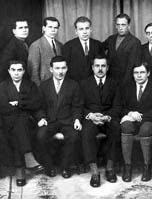
|
VAPLITE (Free Academy of Proletarian Literature). An elitist writers' organization which existed in Kharkiv from 1925 to 1928. While accepting the official requirements of the Communist Party, Vaplite adopted an independent position on questions of literary policy and supported Mykola Khvylovy in the Literary Discussion of 1925-8. Vaplite proposed to create a new Ukrainian literature based on the writers in its ranks who strived to perfect their work by assimilating the finest masterpieces of Western European culture. Joseph Stalin interpreted that goal as a betrayal of the aims of the Party and accused Khvylovy and Vaplite of working under the slogan "Away from Moscow." The association rejected the policy of mass participation in masovism proletarian writers' organizations, which were supported by the Communist Party. Khvylovy was the actual leader of Vaplite; its official president was first Mykhailo Yalovy (Yuliian Shpol) and then Mykola Kulish, and its secretary was Arkadii Liubchenko. The ideas of Khvylovy and Vaplite came under vehement criticism not only from their literary rivals and key Soviet leaders of Ukraine but also officially from the Communist Party (Bolshevik) of Ukraine, and Vaplite was forced to dissolve... |
| Vaplite |
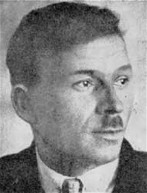
|
KULISH, MYKOLA, b 18 December 1892 in Chaplynka, Tavriia gubernia, d 3 November 1937 in Sandormokh, Karelia region, Russia. The most famous Ukrainian playwright of the twentieth century. After his mother's early death, Kulish spent most of his childhood in orphanages and charity homes. He actively participated in the Ukrainian struggle for Independence (1917-20), organizing a guerrilla regiment to fight the Russian Volunteer Army in Southern Ukraine. Kulish moved to Kharkiv in 1925 where he met the famous writer and polemicist Mykola Khvylovy who had a great impact on Kulish's writing and views. Kulish was also profoundly influenced by Ukraine's leading theater director, Les Kurbas, who staged several of Kulish's plays at his Berezil theater. During his most productive and creative period as a playwright and close collaborator of Les Kurbas, Kulish abandoned the style and tools of traditional, realist dramaturgy. Instead, he experimented with expressionist and avant-garde writing, often combining it with elements of the Ukrainian puppet theater (vertep) and school dramas popular of the seventeenth and eighteenth centuries. His most important plays, such as The People's Malakhii (1927) or Sonata pathetique (1930), address the stark contradictions between Ukrainian national aspirations and Soviet reality... |
| Mykola Kulish |
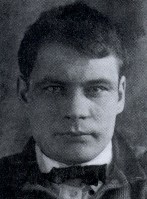
|
YOHANSEN, MAIK, b 28 October 1895 in Kharkiv, d 27 October 1937 in Kyiv. Poet, writer, translator, literary theorist, and linguist of German and Ukrainian parentage. Until 1917 he studied philology at Kharkiv University, graduating with a master's degree. Yohansen wrote in German and Russian until 1917, but only in Ukrainian after 1919. Originally a member of the Soviet Ukrainian proletarian writers' organization Hart, in 1925 Yohansen became a founding member of the literary group Vaplite. After the forced dissolution of Vaplite in 1928 by the Soviet authorities, he cofounded and actively contributed to the literary and art periodicals Literaturnyi iarmarok and Universal'nyi zhurnal. He was the only former Vaplite member to question publically the formation of the more populist literary organization Prolitfront, which he refused to join. Instead he founded the apolitical Techno-Artistic Group A, which was officially banned in 1930. Yohansen was arrested in August 1937, during the Yezhov terror. Soon after he was condemned to death by firing squad for belonging to a fictitious 'Ukrainian bourgeois-nationalist terrorist organization.' The sentence was carried out during the mass executions of political and other prisoners marking the twentieth anniversary of the October Revolution... |
| Maik Yohansen |
_s.jpg)
|
TYCHYNA, PAVLO, b 27 January 1891 in Pisky, Kozelets county, Chernihiv gubernia, d 16 September 1967 in Kyiv. Poet; recipient of the highest Soviet awards and orders; deputy of the Supreme Soviet of the Ukrainian SSR from 1938 and its chairman in 1953-9; director of the Institute of Literature of the Academy of Sciences of the Ukrainian SSR in 1936-9 and 1941-3; and minister of education of the Ukrainian SSR in 1943-8. He graduated from the Chernihiv Theological Seminary in 1913. His first collection of poetry, Clarinets of the Sun (1918), is a programmatic work, in which he created a uniquely Ukrainian form of symbolism and established his own poetic style, known as kliarnetyzm (clarinetism). During the early years of the Bolshevik occupation of Ukraine, marked by terror, ruin, famine, and suppression of the national uprising, Tychyna maintained his position as an independent poet and quickly established himself as the leading Ukrainian poet. In 1923 he moved to Kharkiv and joined the organization Hart and, in 1927, Vaplite. His membership in the latter organization and his poem Mother Was Peeling Potatoes provoked harsh official criticism, and the poet was accused of 'bourgeois nationalism.' Soon after, Tychyna capitulated to the Soviet regime and began producing collections of poetry in the socialist-realist style sanctioned by the Party... |
| Pavlo Tychyna |
_s.jpg)
|
YANOVSKY, YURII, b 27 August 1902 on Maierove khutir, Yelysavethrad county, Kherson gubernia, d 25 February 1954 in Kyiv. Writer. From 1927 Yanovsky lived in Kharkiv, and from 1939, in Kyiv. He began publishing poems in Ukrainian in 1924, and after 1927 he wrote only prose. Yanovsky is considered, with Mykola Khvylovy (with whom he belonged to the elitist writers' organization Vaplite), one of the best neoromantic writers in Ukrainian literature in the first half of the 20th century. The sea, which he portrayed romantically, was his favorite subject, as is most clearly seen in his first novel, The Figurehead (1928). He subsequently published Four Sabers (1931), which was harshly criticized and was banned for a long time by the Communist authorities. In that novel he described in a Romantic manner the spontaneous popular movement in reborn Ukraine during the period of the struggle for independence (1917-20). Yanovsky returned to the same subject in The Horsemen (1935), although there, owing to the pressure of Stalinist censorship, he applied the official interpretation. The work is a finely wrought novel composed of short stories. Yanovsky's early prose works are classics of the Ukrainian literary rebirth of the first half of the 20th century... |
| Yurii Yanovsky |
The preparation, editing, and display of the IEU entries associated with Vaplite writers and the Ukrainian cultural renaissance of the 1920s were made possible by the financial support of the MICHAEL KOWALSKY AND DARIA MUCAK-KOWALSKY ENCYCLOPEDIA ENDOWMENT FUND at the Canadian Institute of Ukrainian Studies (Edmonton, AB, Canada).
 XII. MYKOLA ZEROV AND THE UKRAINIAN NEOCLASSICISTS
XII. MYKOLA ZEROV AND THE UKRAINIAN NEOCLASSICISTS
The nucleus of the group of the Ukrainian Neoclassicists of the 1920s consisted of Mykola Zerov, Maksym Rylsky, Pavlo Fylypovych, Mykhailo Drai-Khmara, and Oswald Burghardt (Yurii Klen). They never established a formal organization or program, but they shared cultural and esthetic interests. Mykhailo Mohyliansky, Viktor Petrov, and others are also included in this loose grouping. The group's name is derived from their use of themes and images of antiquity and was given to them by their opponents in the Literary Discussion of 1925-8. The Neoclassicists were self-consciously concerned with the production of high art and disdained 'mass art,' didactic writing, and propagandistic work. Their opponents, in contrast, organized themselves around writers who were supported by the Communist party, and viewed literature in a primarily utilitarian fashion, that is, as a means of strengthening Soviet rule in Ukraine. In the 1930s Mykola Zerov, Pavlo Fylypovych, and Mykhailo Drai-Khmara were sent to Soviet concentration camps and perished there. Maksym Rylsky was forced to publish socialist-realist works, and Burghardt emigrated to the West, where he wrote under the pseudonym Yurii Klen. The tradition of the Neoclassicists was continued among emigre poets, most notably by M. Zerov's brother, Mykhailo Orest... Learn more about the literary legacy of the Neoclassicists by visiting the following entries:
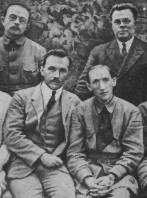
|
NEOCLASSICISTS. A literary movement of the 1920s. The works of the Neoclassicists were anti-Romantic and antifolkloric. They sought universal themes and considered Ukrainian culture to be an organic part of Western European culture. The closest to what could be considered their program was set out by Mykola Zerov. 'We should,' he wrote, 'assimilate the highest culture of our times, not only in its latest manifestations, but also in its original forms.' From that commitment stemmed the demands the Neoclassicists made of a writer: (1) a comprehensive knowledge of the best works of Ukrainian literature; (2) a comprehensive knowledge of the achievements of world literature; and (3) poetic craftsmanship of the highest level. High art, in their view, could be conveyed only through clarity of thought and mastery of form. Their poetry, therefore, is characterized by balance, plasticity of image, and logical ordering of subject and composition. The main purpose of literature, as they perceived it, was esthetic... |
| Neoclassicists |
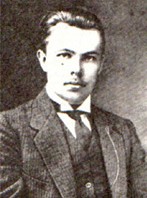
|
ZEROV, MYKOLA, b 26 April 1890 in Zinkiv, Poltava gubernia, d 3 November 1937 in the Solovets Islands. Poet, translator, and literary historian. He studied philology at Kyiv University. He was a professor of Ukrainian literature at the Kyiv Architectural Institute (1918-20), the Kyiv Co-operative Tekhnikum (1923-5), and the Kyiv Institute of People's Education (1923-35). Zerov's literary activity, both as a poet and as a translator, was in complete harmony with his ideals and theoretical postulates. An avowed classicist and Parnassian, he became the leader of the Neoclassicists. He concentrated on the sonnet and Alexandrine verse and produced excellent examples of both forms. He translated numerous works of Latin poetry. He wrote literary criticism on contemporary Soviet Ukrainian literary works, articles on literary translation, and introductions to editions of Ukrainian classics. He was arrested in April 1935 and sentenced to 10 years' imprisonment in the Solovets Islands. On 9 October 1937 he was resentenced, to death by firing squad... |
| Mykola Zerov |
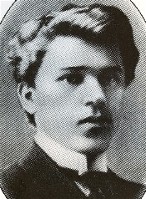
|
DRAI-KHMARA, MYKHAILO, b 10 October 1889 in Mali Kanivtsi, Poltava gubernia, d 19 January 1939, Kolyma region, Siberia. Poet, linguist, literary scholar, translator. Drai-Khmara studied at the Galagan College (1906-10), Kyiv University (1910-15), and Petrograd University (1915-17). He became a specialist in Ukrainian, Belarusian, and Serbian literatures and the history of the Serbian and Belarusian languages. He was professor of Ukrainian studies at Kamianets-Podilskyi Ukrainian State University (1918-21) and at the Kyiv Medical Institute (1923-9). He began writing poetry in 1910, and in the 1920s was a member of the Neoclassicists. His early poetry was lyrical, emotive, and essentially symbolist. His later poetry combined symbolist elements with an increasing attention to form, language, and imagery reminiscent of Kyivan neoclassicism. He was first arrested in February 1933. Rearrested in September 1935, he was sentenced for 'counterrevolutionary terrorism' in March 1936 and perished in a Kolyma labor camp... |
| Mykhailo Drai-Khmarah |
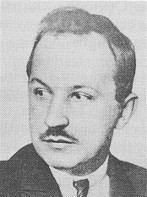
|
FYLYPOVYCH, PAVLO, b 1 September 1891 in the village of Kaitanivka, Kyiv gubernia, d 3 November 1937. Poet and literary scholar. Fylypovych studied at Galagan College and at Kyiv University (1910-5), where he later was a professor (1917-35). His first poems were published in Russian journals beginning in 1910. After the Revolution of 1917 Fylypovych switched to writing poetry in Ukrainian. In the 1920s he became a member of the Neoclassicists and published two collections of poetry. Fylypovych was an associate member of the All-Ukrainian Academy of Sciences and secretary of its Historical-Literary Society. He made a major contribution to the comparative study of Ukrainian literature, particularly to the study of Taras Shevchenko and Ukrainian romanticism. Fylypovych was arrested in August 1935 during the Stalinist terror, presumably for his critical attitude to official Soviet cultural policies, and sentenced to 10 years in concentration camps. He died in a camp in the Ukhta-Pechorsk region of Siberia... |
| Pavlo Fylypovych |
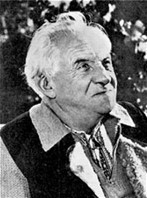
|
RYLSKY, MAKSYM, b 19 March 1895 in Kyiv, d 24 July 1964 in Kyiv. Poet, translator, and community activist. He studied at Kyiv University, initially in the medical faculty and later in the historical-philological faculty. Rylsky started to write early in life (he published his first poem in 1907), and by 1910 he had published his first youthful collection. His poetic talents reached full bloom with the publication of several poetry collections in the 1920s. Rylsky's lyric poetry grew out of the best achievements of Ukrainian poetry at his time, and out of his broad knowledge of world poetry, French writers in particular. He often used motifs and images from ancient mythology and adhered to classical forms, which practices linked him to the group of Neoclassicists. In many other respects, however, his philosophical and contemplative lyric poetry did not fit the narrow definition of Neoclassicism. Rylsky's apolitical poetry provoked fierce attacks from official critics. He was arrested in 1931, but then proclaimed his acceptance of the official Soviet view of reality.... |
| Maksym Rylsky |
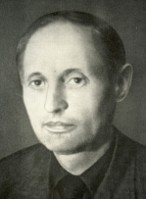
|
KLEN, YURII (pseud of Oswald Burghardt), b 4 October 1891 in Serbynivtsi, Podilia gubernia, d 30 October 1947 in Augsburg, Germany. Writer, poet, literary scholar, and translator. After graduating from Kyiv University, he published in Russian a study on the latest analyses of poetic style (1915). Because he was the son of German colonists, he was exiled during the First World War to the Arkhangelsk region of northern Russia. Returning to Ukraine after the Revolution of 1917, he worked as a teacher in Baryshivka. There he renewed his friendship with the scholar and poet Mykola Zerov and began writing poetry in Ukrainian. Klen became one of the unofficial five-member group called the Neoclassicists. Although his poems began to appear in the periodical press beginning in 1924, his major contributions were his translations of German, French, and English poetry. In 1931 Klen managed to emigrate to Germany and taught Slavic literatures at the universities of Munster, Innsbruck, and Prague.... |
| Yurii Klen |
The preparation, editing, and display of the IEU entries associated with the literary legacy of the Ukrainian Neoclassicists of the 1920s were made possible by a generous donation from ARKADI MULAK-YATSKIVSKY of Los Angeles, CA, USA.
 XIII. UKRAINIAN LITERARY AVANT-GARDE OF THE 1910s AND 1920s
XIII. UKRAINIAN LITERARY AVANT-GARDE OF THE 1910s AND 1920s
Among the most dynamic and interesting, though often underrated, trends in the Ukrainian literature of the 1910s and 1920s were the urban-oriented, antitraditional, avant-garde movements such as futurism and constructivism. The Ukrainian futurism was intruduced in 1914 by Mykhailo Semenko whose writing abounded with city-life themes and subjects inspired by the Italian futurist Filippo Marinetti, and whose poetry was characterized by experimentation with form and language which attempted to shock the reader. As an active proponent of futurism, Semenko founded several Ukrainian futurist organizations and journals: Fliamingo (1919-21), ASPANFUT (Association of Panfuturists, 1921-4), and, after moving to Kharkiv from Kyiv, Nova Generatsiia (1927-30). A number of talented poets and prose writers belonged to the futurist group: Geo Shkurupii, Oleksa Vlyzko, Mykola Skuba, and the theoretician Oleksii Poltoratsky. The eminent poet Mykola Bazhan and the greatest poet of the Ukrainian revolutionary period, Pavlo Tychyna, were for some time influenced by futurism and utilized some of its ideas in their work. The poet Valeriian Polishchuk was closely associated with futurism and the avant-garde, on the basis of which he tried to build his own movement of 'dynamic spiralism.' The futurists were never as prominent in the Ukrainian literature of their time as the symbolists or Neoclassicists, who never severed their ties with the past. Yet the futurists succeeded in reinvigorating poetry by introducing fresh themes and forms and above all by their experimentation. The group Nova Generatsiia propagated new Western European trends such as Dadaism and surrealism, although this practice conflicted with its journal's official crude sociological declarations. The majority of futurist writers and poets, including Semenko, Shkurupii, and Polishchuk, were executed for 'nationalism' during the Stalinist terror of the 1930s... Learn more about the Ukrainian literary avant-garde of the 1910s and 1920s by visiting the following entries:
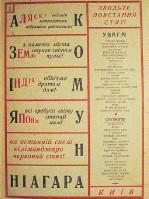
|
FUTURISM. Art movement that originated in Italy in 1909. Its founder is considered to be Filippo Marinetti, whose main objective was to destroy old art forms, particularly realism and classicism, the dominant trends of the 19th century. Cubism still recognized a certain convention, while futurism rejected all accepted forms and gave individualism free reign. In painting this freedom led to fantastic forms and colors, and in literature, especially poetry, to abstruse language (zaumna mova) consisting of sound-words that often had no meaning. Futurism sought to transmit the ideas and spirit of the future technological and cosmopolitan society, which was opposed to the old conservative esthetic sensibility of the peasants and petite bourgeoisie. Hence, urban and industrial themes were typical of this movement. Futurism did not receive much sympathy in Ukraine before the First World War. Such works as Alexander Archipenko's Dance or Medrano I (1912) were produced in Paris and were known in Ukraine only from reproductions. In the fine arts, besides Archipenko, who left Ukraine in 1906, the following artists were closely associated with futurism of the constructivist rather than the anarchist bent (the so-called cubo-futurism): Alexandra Ekster, Oleksander Bohomazov, Anatol Petrytsky, Kazimir Malevich, and others. The first collection of Ukrainian futurist poetry was published by Mykhailo Semenko in 1914... |
| Futurism |
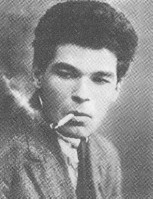
|
SEMENKO, MYKHAILO, b 31 December 1892 in Kybyntsi, Myrhorod county, Poltava gubernia, d (executed) 23 October 1937. Poet, writer, and founder and theoretician of Ukrainian futurism. Semenko's first poetry collection, Preludes (1913), shows the influence of the modernist poets of the journal Ukraďns'ka khata. However, in the collections that followed, such as Kverofuturyzm (Quero-Futurism, 1914), he initiated Ukrainian 'quero-futurism,' or the art of searching. He embraced urban themes and caused a scandal by adamantly rejecting the poetry of Taras Shevchenko. In 1919 Semenko proclaimed the beginning of 'revolutionary futurism' and published his first 'revolutionary futurist' poems. In 1920 he organized the Shock Brigade of Futurist Poets, later called the Association of Panfuturists (Aspanfut), which published its credo and manifestos in the almanac Semafor u maibutnie (Semaphores into the Future, 1922). From 1924 to 1927 he worked as editor in chief of the Odesa Film Studio and in 1925 produced the poetic film Step (The Steppe). In 1924 he published two collections of his works from 1910 to 1922, both provocatively entitled Kobzar. In 1927 he founded a new futurist association called Nova Generatsiia. After of severe criticism by the Communist party, Semenko abandoned futurism and became a poet of the Bolshevik revolution. Nevertheless he was arrested in 1937 and executed with other Ukrainian writers...
|
| Mykhailo Semenko |
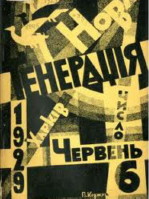
|
NOVA GENERATSIIA (New Generation). A literary organization of futurists, established in Kharkiv in 1927 by former members of the Association of Panfuturists, Mykhailo Semenko, Geo Shkurupii, Oleksii Poltoratsky, A. Chuzhy, Mykola Skuba, and others, and new members such as Dmytro Buzko. Its program embraced the propagandistic slogans of internationalism and proletarian culture and was combined with an imperative to modernize Ukrainian literature by putting it in touch with contemporary literary currents in the West. The organization's official organ bore the same name, Nova generatsiia. Much of its contents were devoted to contemporary literary polemics and to the popularization of currents in literature and art in the West (eg, G. Apollinaire, Le Corbusier, W. Baumeister). In 1929, under severe criticism from the Communist party critics, the name was changed to the All-Ukrainian Association of Workers of Communist Culture, and in 1930, to the Alliance of Proletarian Writers in Ukraine. In 1931 the organization was forced to disband. Most of its members were executed during the Stalinist terror, although some, such as O. Poltoratsky, succumbed to pressure and adopted the Party line... |
| Nova Generatsiia |
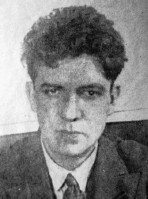
|
SHKURUPII, GEO (Yurii), b 20 April 1903 in Bendery, Bessarabia gubernia, now in Moldova, d (executed) 8 December 1937 in Leningrad. Writer of poetry and prose. One of the most prominent and talanted representatives of Ukrainian literary futurism. His first published work appeared in the almanac Hrono in 1920. He was an active member of the Association of Panfuturists and Komunkult, and subsequently Nova Generatsiia. His collections of poetry include Psykhotezy (Psychotheses, 1922) and Baraban (The Drum, 1923), but his first important futurist collection was Zharyny sliv (The Embers of Words, 1925). In 1925 he also publishes his first prose works, a collection of adventure short stories Peremozhets' drakona (The Slayer of the Dragon). He went on to produce several short story collections and three novels, including Dveri v den (The Door to the Day, 1929), Zhanna batalionerka (Zhanna the Battalion Member, 1930), and Mis Andriiena (Miss Andriena, 1934). Severly criticized by the official Party critics, he was arrested in 1934, sentenced to 10 years in concentration camps, resentenced by a special NKVD tribunal, and executed... |
| Geo Shkurupii |
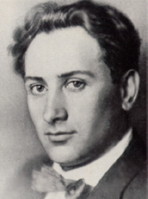
|
POLISHCHUK, VALERIIAN, b 1 October 1897 in Bilche, Dubno county, Volhynia gubernia, d (executed) 9 October 1937 in Sandarmokh, Karelia region, RFSSR. Writer and literary critic and theorist. His first published work appeared in 1918. In 1921, together with Petro Yefremov and Valeriian Pidmohylny, he published the literary and artistic miscellany Vyr revoliutsii (Vortex of the Revolution) in Sicheslav (now Dnipropetrovsk). From that year he worked for newspapers in Kharkiv. There he joined the writers' group Hart in 1923, and in 1925 he founded the smaller group Avanhard (Avant-garde), which advanced a program of constructivist dynamism (or spiralism) and was influenced heavily by Russian (Ilia Selvinsky), west European (Emile Verhaeren), and American (Walt Whitman) avant-garde literature. Polishchuk elaborated the idea of free-verse khvyliady ('wave cycles'). He produced over fifty books of poetry, prose, essays, and children's literature. He also wrote the short novels Chervonyi potik (Red Stream, 1926) and Hryhorii Skovoroda (1929) and a book about the Donbas, Povist' metalu i vuhillia (A Tale of Metal and Coal, 1931). Polishchuk was arrested and tried in 1934 for belonging to a fictitious anti-Soviet 'Ukrainian National Socialist party.' In 1935 he was sentenced to ten years in a prison on the Solovets Islands, where he was later executed by the NKVD... |
| Valeriian Polishchuk |
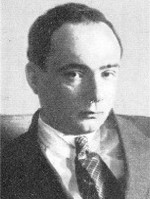
|
BAZHAN, MYKOLA, b 9 October 1904 in Kamianets-Podilskyi, d 23 November 1983 in Kyiv. Poet, writer, translator, and Soviet Ukrainian political and cultural figure; full member of the Academy of Sciences of the Ukrainian SSR from 1951. One of the most prominent representatives of the literary renaissance of the 1920s, he wrote screenplays, edited the journal Kino, and was associated with the literary groups Vaplite and Nova Generatsiia and the journal Literaturnyi iarmarok. Bazhan's poems were first published in 1923, but he gained recognition for the avant-garde poetry collection 17-i patrul' (The 17th Patrol, 1926). With the collection Budivli (Buildings, 1929), he abandoned futurism and constructivism and emerged as a romantic expressionist, whose poems were characterized by dynamism, unusual imagery, monumentalism, and frequent references to the Ukrainian past. In the poem 'Budivli' he treats historical themes, seeking a link between the modern era, the Middle Ages, and the Ukrainian baroque of the Cossack state. His poems 'Rozmova serdets' (Heart-to-Heart Talk), in which he presented an unusually harsh assessment of Russia, 'Hofmanova nich' (Hoffman's Night, 1929), 'Sliptsi' (The Blind Beggars, 1933), and others aroused harsh criticism of Bazhan by the Communist party: he was accused of 'detachment from Soviet reality', 'idealism', and nationalism. During the terror of 1934-7 Bazhan capitulated to the Party pressure and wrote poems in the spirit of 'Stalinist patriotism'... |
| Mykola Bazhan |
The preparation, editing, and display of the IEU entries about the Ukrainian literary avant-garde of the 1910s and 1920s were made possible by the financial support of the CANADIAN FOUNDATION FOR UKRAINIAN STUDIES.
 XIV. THE 'FELLOW TRAVELERS' IN SOVIET UKRAINIAN LITERATURE OF THE 1920s
XIV. THE 'FELLOW TRAVELERS' IN SOVIET UKRAINIAN LITERATURE OF THE 1920s
After the Revolution of 1917, the term 'fellow traveler' (Russian: poputchik) was applied in the Soviet Union to writers who seemed to accept the revolution, but who declined to join the Communist Party and were not active participants of Soviet political life. Apart from the group of Ukrainian Neoclassicists, the most prominent 'fellow travelers' in the Soviet Ukrainian literature of the 1920s assembled in a literary organization Lanka, established in 1924 and renamed MARS in 1926. The group included several talented writers of varying literary predilections who were united by their desire to be independent of official politics in the area of literature. They included Valeriian Pidmohylny, Borys Antonenko-Davydovych, Hryhorii Kosynka, Teodosii Osmachka, Yevhen Pluzhnyk, and others. Together with the Neoclassicists, for a long time they continued their opposition to the politicization of literature. They were forced to disband in 1929. Most of the members were executed during the Stalinist terror; Osmachka managed to emigrate at the end of the Second World War, and B. Antonenko-Davydovych was persecuted until his death in Kyiv in 1984. Several other 'fellow travelers,' such as Mykhailo Ivchenko, remained unaffiliated to any literary organizations, but this has not saved them from persecution by the Stalinist regime which took full control over literature in the early 1930s, banned all independent organizations, and proclaimed socialist realism as the sole acceptable literary manner... Learn more about the legacy of the 'fellow travelers' in the Ukrainian literature of the 1920s by visiting the following entries:
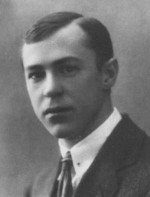
|
PIDMOHYLNY, VALERIIAN, b 2 February 1901 in Chapli, Katerynoslav county, d 3 November 1937 in the Solovets Islands. Writer and translator, member of the literary organization Lanka (later MARS). In the early 1920s, Pidmohylny published several collections of stories and a novelette Ostap Shaptala (1922). His early works focus on various pre- and postrevolutionary realities, such as the Famine of 1921-3. His most notable work is the novel Misto (The City, 1928), one theme of which captures the relationship between the city and the village against the backdrop of the New Economic Policy. His last published work was Nevelychka drama (A Little Drama, 1930). Pidmohylny's translations, particularly those of the works of Honore de Balzac, Denis Diderot, Anatole France, Guy de Maupassant, and Stendhal, significantly influenced the development of Ukrainian literature in the 1920s. He was arrested in 1934 during the Stalinist terror and executed along with many other Ukrainian writers... |
| Valerian Pidmohylny |
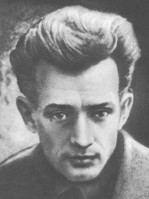
|
PLUZHNYK, YEVHEN, b 26 December 1898 in Kantemyrivka, Voronezh gubernia, d 2 February 1936 in the Solovets Islands. Writer. In the years 1923-8 he belonged to the Kyiv writers' groups Aspys, Lanka, and MARS and contributed poetry to several journals. During his lifetime he published only two poetry collections; a third, Rivnovaha (Equilibrium), first appeared posthumously in an emigre edition in Augsburg in 1948. He wrote the novel Neduha (Illness, 1928), which was banned from circulation shortly after its publication. He was also the author of two plays and a novel in verse. Although Pluzhnyk was one of the finest Ukrainian poets of the 1920s (he has been compared to Rainer Maria Rilke), Party criticism was hostile to his contemplative, laconic, and frequently gloomy lyricism and depiction of revolutionary atrocities and Soviet reality. In December 1934, during the Stalinist terror, he was arrested together with many other Ukrainian figures, and he died of the tuberculosis in a Soviet labor camp in the Solovets Islands... |
| Yevhen Pluzhnyk |
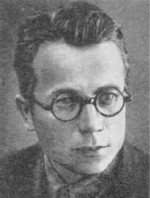
|
KOSYNKA, HRYHORII (pseud of Hryhorii Strilets), b 29 November 1899 in Shcherbanivka, Kyiv gubernia, d 17 December 1934 in Kyiv. Writer. From 1920 he lived in Kyiv and belonged to the writers' groups Hrono, Aspys, Lanka, and MARS. His first story appeared in 1919. About 20 of his story collections were published during his life while publication of his last collection Sertse (The Heart, 1933) was prevented by the censors. Party critics accused Kosynka of propagating 'kulak ideology' and 'counterrevolutionary tendencies' in his stories. Arrested during the Stalinist terror, he and 36 others were tried on fabricated charges of terrorist activity by a military tribunal, and he and 27 others were summarily shot. Kosynka was one of the more outstanding Soviet Ukrainian story writers of the 1920s and early 1930s. His stories captured the prevalent attitudes, relations, and political shifts among the Ukrainian peasantry during the 1917-21 period of revolutionary upheaval and war. He employed a unique style, in which examples of expressionism and experimentation abound... |
| Hryhorii Kosynka |
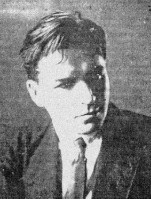
|
ANTONENKO-DAVYDOVYCH, BORYS (pseud of Borys Davydov), b 5 August 1899 in Romny, Poltava gubernia, d 9 May 1984 in Kyiv. Writer, journalist, and an active participant in the post-1917 renaissance of Ukrainian culture. Antonenko-Davydovych studied natural science at Kharkiv University and philology in Kyiv. He was a member of the literary group Lanka (MARS). His early works include the drama Lytsari absurdu (Knights of the Absurd, 1924) and several collections of stories and short novels. Antonenko-Davydovych's novel Smert' (Death, 1928), which became very popular but was at the same time sharply criticized for nationalism, describes the then-current problem of the betrayal of his nation by a Ukrainian intellectual who becomes a Communist. He was arrested in 1935, imprisoned until 1956, and then exiled to Central Asia. He returned to Kyiv in 1957 and had a significant influence on the Ukrainian literary generation of the 1960s. For his protests against Russification and his defense of Ukrainian dissidents he was again persecuted from the mid-1960s... |
| Borys Antonenko-Davydovych |
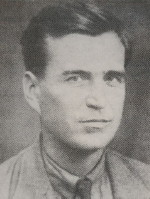
|
OSMACHKA, TEODOSII, b 3 May 1895 in Cherkasy county, Kyiv gubernia, d 7 September 1962 in Long Island, New York State. Poet, novelist, and translator. Although his first poems were written in 1916, Osmachka began his literary career in Kyiv in the early 1920s. He belonged to the literary organizations Aspys and Lanka (MARS), and published his first collection of poetry in 1922. It was followed by two more collections in 1925 and 1929. Like other members of MARS he was attacked and arrested for his 'unpolitical' literary works, but managed to save himself from execution by feigning insanity. During the 1930s he faced constant persecution by the authorities and was unable to publish any works. During the Second World War he fled to Western Ukraine, then to displaced persons camps in Germany, and finally to the United States. Osmachka's personal ordeal had lasting effects on him, and until his death he suffered from a persecution complex. Nonetheless he resumed his literary career and published his epic poem Poet (Poet, 1946) as well as several prose works portraying the genocidal destruction of Ukraine by the Soviet regime... |
| Teodosii Osmachka |
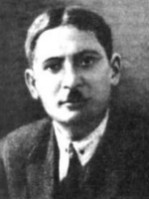
|
IVCHENKO, MYKHAILO, b 9 August 1890 in Nykolivka, Poltava gubernia, d 16 October 1939 in Vladykavkaz, Russia. Writer. Before the Revolution of 1917 he worked as a statistician in the Poltava region and wrote articles on economics, natural science, and the national question. A Soviet 'fellow traveler' in the 1920s, member of the literary organizations Muzahet and Aspys, he was the author of the impressionistic prose collections, such as Shumy vesniani (The Murmurs of Spring, 1919) and Zemli dzvoniat' (The Lands Peal, 1928). His most significant work, the novel Robitni syly (The Work Forces, 1929), portrays allegorically the fostering of national consciousness. A defendant at the show trial of the Union for the Liberation of Ukraine in 1930, he received a conditional sentence. To avoid another arrest, in 1934 he left Ukraine for Moscow and then settled in Vladykavkaz in Caucasia. He translated into Ukrainian the prose of Rabindranath Tagore with whom he corresponded in the 1920s... |
| Mykhailo Ivchenko |
The preparation, editing, and display of the IEU entries featuring the legacy of the 'fellow travellers' in the Soviet Ukrainian literature of the 1920s were made possible by the generous financial support of ARKADI MULAK-YATSKIVSKY of Los Angeles, CA, USA.
 XV. THE YIDDISH-LANGUAGE WRITERS OF KYIV'S KULTUR LIGE
XV. THE YIDDISH-LANGUAGE WRITERS OF KYIV'S KULTUR LIGE
In January 1918, during the period of the Ukrainian Central Rada, a Jewish cultural and social organization called Kultur Lige (Culture League) was founded in Kyiv. The Kultur Lige enjoyed the support of the Ukrainian Ministry of Jewish Affairs under the General Secretariat of the Central Rada as well as of a political coalition that included several Jewish left-wing parties. This organization aimed to cultivate a unique Jewish culture of Ukraine through the creative work in the Yiddish language. Its areas of interest were wide-ranging and covered every aspect of contemporaneous Yiddish culture, including education, literature, theater, art, and music. As such, it played a pivotal role in fostering Jewish cultural and intellectual life in Ukraine during that period. The Kultur Lige had several sections: literature, theatre, painting and sculpture, pre-school, and higher education. Later, at the beginning of 1919, sections for Jewish statistics and archives began operating. The activity of the Kultur Lige peaked in 1919-20, when it organized and supported sixty-three Yiddish schools, fifty-four libraries, and numerous choirs, drama clubs, the Jewish People's University, a Jewish gymnasium, a teachers' seminary, courses for Jewish teachers, the Kultur Lige publishing house, and more. The most prominent Yiddish-language writers in Ukraine of that time, including David Bergelson, David Hofstein, Leib Kvitko, Perets Markish, or Der Nister (Pinkhus Kahanovych), were in one way or another associated with the Kultur Lige. Most of these writers eventually moved to Moscow and later, almost all of them were arrested during the Stalinist post-World War II purges of Jewish culture. On 12 August 1952 virtually all of them were executed in the Lubianka Prison in Moscow during what is sometimes referred to as 'the Night of the Murdered Poets'... Learn more about the Yiddish-language authors associated with the Kyiv-based Kultur Lige, by visiting the following entries:
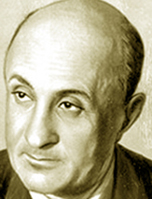
|
HOFSTEIN, DAVID, b 24 June 1889 in Korostyshiv, Kyiv gubernia, d 12 August 1952 in Moscow. Yiddish poet, writer, dramatist, and translator. Hofstein began to write poetry in Hebrew at the age of nine. Later, under the pseudonym D. Naumov, he expanded his poetic repertoire to include Russian, Ukrainian, and Yiddish. He made his Yiddish debut in print in 1917 in Kyiv. He soon became a prominent figure in Jewish literary life of the city and assumed multiple roles, including an administrator of the Kultur Lige. Between 1919 and 1922 he published six poetry collections and, together with the poets Leib Kvitko and Perets Markish, he made up the so-called Kyiv lyric triad of Yiddish poets (or Kyiv Group). Hofstein was also a prolific translator, with a particular focus on the poetry of Taras Shevchenko, Lesia Ukrainka, and Ivan Franko. In 1920 his article on Shevchenko and his translation of Shevchenko's 'Testament' were published in a Yiddish-language brochure Tsum yortsayt fun Taras Shevchenko (On the Anniversary of Taras Shevchenko's Death). A book of his Yiddish-language translations of the selected works of Lesia Ukrainka was published in Kyiv in 1931, while his translations of Ivan Franko's selected works were published in 1936. He also co-edited an anthology of Yiddish literature in Ukrainian...
|
| David Hofstein |
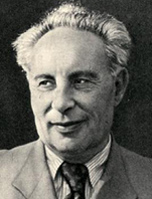
|
KVITKO, LEIB, b 15 October 1890 in Holoskiv, Podilia gubernia, d 12 August 1952 in Moscow. Yiddish poet and novelist. In 1918, as an active member of the Kultur Lige, Kvitko published in Kyiv a book Lidelekh (Songs). Together with David Hofstein and Perets Markish, he formed the so-called Kyiv lyric triad of Yiddish poets. They displayed an affinity with the contemporaneous modernist movements among Ukrainian writers who aspired to blend European sensibilities with their own national essence, albeit with an evident impact from the Russian symbolist circles. From 1920 to 1925 Kvitko lived and published in Germany (Berlin and Hamburg), where he joined the German Communist Party and participated in the underground. Fearing arrest, in 1925 he returned to the USSR, where he worked on the editorial board of the magazine Di Royte Velt and published a series of stories about life in Hamburg. From 1926 to 1936 he lived in Kharkiv and wrote mostly children's stories and poems. He was also a member of Ukrainian literary organizations Vaplite and later Prolitfront. In September 1929, the Yiddish Section of the All-Ukrainian Association of Proletarian Writers held an extraordinary meeting to address Kvitko's perceived 'anti-communist pasquinade.' As a result, he was dismissed from his job and later persecuted... |
| Leib Kvitko |
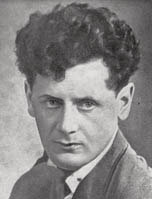
|
MARKISH, PERETS, b 7 December 1895 in Polonne, Novohrad-Volynskyi county, Volhynia gubernia, d 12 August 1952 in Moscow. Soviet Yiddish poet, novelist, and playwright. In 1918-19, Markish's first poems appeared in Yiddish modernist journals published by the Kyiv-based Kultur Lige. In 1919 he published his first book of poetry Shveln (Thresholds), and he soon gained recognition as a representative of the Kyiv lyric triad of Yiddish poets (with David Hofstein and Leib Kvitko). In 1920 Markish relocated to Moscow and in 1921 he was one of the founders of the Moscow Circle of Jewish Writers and Artists. Between 1921 and 1926 he lived in Poland and France, where he was part of the expressionist literary movement. After his return to the USSR in 1926, he largely conformed to socialist realism and began writing about industrialization, collectivization, and various aspects of Soviet life. In 1942 he became a card-carrying member of the Communist Party and, throughout the war, served on the board of the Jewish Anti-Fascist Committee. Alongside David Bergelson and Isaac Fefer, Markish was one of the most widely known Yiddish writers in the USSR. However, during the postwar Stalinist purges of Jewish culture he was arrested in 1949, imprisoned, and later executed. |
| Perets Markish |
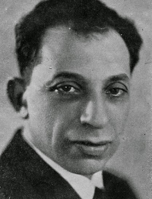
|
BERGELSON, DAVID, b 12 August 1884 in Okhrimove, Uman county, Kyiv gubernia, d 12 August 1952 in Moscow. Yiddish writer and literary figure. Born into a prosperous Hasidic family, he was forced to leave his home following the death of his mother in 1898 and reside with his older siblings in Odesa, Kyiv, and Warsaw. In 1903 he settled in Kyiv. In 1919 he was one of the founders of the Kultur Lige and worked as an editor of the literary miscellany Eygns. In 1921 Bergelson settled in Berlin, where he published the first edition of his collected works. There he also edited, together with Der Nister, the literary section of the Yiddish magazine Milgroym. In 1926 he made a significant shift in his career when he aligned himself with the New York-based pro-communist publication Frayhayt. Following this, he returned to the Soviet Union, assuming the role of a journalistic representative of Frayhayt. Between 1928 and 1934 Bergelson resided in the United States, Berlin, and Copenhagen, before returning to the Soviet Union in 1934. In 1942, he became part of the Jewish Anti-Fascist Committee (JAFC), and during the postwar Stalinist purges of Jewish culture, he was arrested together with other JAFC members, imprisoned, subjected to torture, and later executed... |
| David Bergelson |
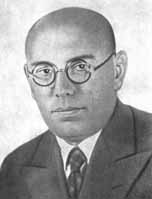
|
FEFER, ISAAC, b 9 October 1900 in Shpola, Kyiv gubernia, d 12 August 1952 in Moscow. Yiddish poet and Communist activist. In 1917 Fefer became a member of the Bund and a trade union activist. He then joined the Communist movement in 1919 and served in the Red Army. He began writing poetry in 1918 and gained recognition as a Yiddish poet, whose work focused primarily on political themes and romantic depictions of the revolutionary struggle. In 1927 Fefer was a founding member of the Jewish Section of the All-Ukrainian Association of Proletarian Writers and edited a number of Yiddish periodicals in Kharkiv and Kyiv in the 1930s. Between 1942 and 1945 he was one of the leaders of the Jewish Anti-Fascist Committee (JAFC). In 1943 Fefer visited the United States, Canada, Mexico, and England to promote support for the Soviet Union. He returned to the USSR with a wider appreciation of the Jewish life outside of the Soviet Union and initiated discussions to have the JAFC join the World Jewish Congress to end the isolation of Soviet Jews. He was arrested in 1948 and charged with membership in an anti-Soviet conspiracy organized by Jews in the United States. He was later executed, together with other JAFC leaders, in the Lubianka Prison in Moscow... |
| Isaac Fefer |
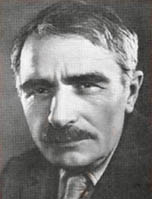
|
DER NISTER (Yiddish: 'The Hidden One,' pseud. of Pinkhus Kahanovych), b 1 November 1885 in Berdychiv, d 4 June 1950 in the Abez GULAG labor camp, Komi ASSR, RSFSR. Yiddish writer and poet. He came from the family of Orthodox Jews with ties to the Korshev (Korostyshiv) Hasidic sect. His brother, Aaron, who became a member of the sect following the teachings of Rabbi Nakhman of Bratslav, exerted a profound influence on Der Nister's future creative work. In 1918 Der Nister settled in Kyiv, where he became part of a community that revolved around the Kultur Lige. In 1920 he moved with his family to Moscow. From there he relocated via Poland to Berlin where, in 1922 and 1923, two volumes of his Gedakht (Thought) were published. In 1926 he returned to Ukraine and settled in Kharkiv, where in 1928 he published a collection of symbolist stories, Fun mayne gitter (From My Estates). At the end of the 1920s, in the atmosphere of tightening Communist Party control over literature, the symbolist and mystical Der Nister came under harsh criticism from the Soviet authorities. For nearly a decade he lived in abject poverty. In February 1949, Der Nister was among the last of the major Yiddish writers to be arrested during the Stalinist postwar purges. He died in a Soviet prison hospital... |
| Der Nister |
The preparation, editing, and display of IEU articles about the Yiddish-language authors associated with the Kyiv-based Kultur Lige, were made possible by the financial support of the CANADIAN FOUNDATION FOR UKRAINIAN STUDIES.
 XVI. SOCIALIST REALISM IN THE SOVIET UKRAINIAN LITERATURE
XVI. SOCIALIST REALISM IN THE SOVIET UKRAINIAN LITERATURE
The term socialist realism and its theoretical underpinnings were officially adopted by the First Congress of Writers of the USSR in August 1934, when the Soviet Writers' Union was established. This so-called 'creative method' was imposed by the Stalinist regime during its campaign of terror following the dissolution of all independent literary organizations, as a result of which the Communist Party gained full control over arts and literature in the USSR. As the only officially sanctioned 'method' in Soviet literature and art from the early 1930s, socialist realism demanded 'depiction of reality in its revolutionary development' that 'must be tied to the ideological re-education and training of workers in the spirit of socialism.' In practical terms, this meant that literature and art were to serve as glorifying illustrations of the Communist Party policies, and to portray what was hoped for in such a way that it seemed real. Deviations into truly realistic portrayals of Soviet reality and its deficiencies were attacked as 'slavishness to facts' or 'anti-Soviet agitation and propaganda.' Socialist realism was enforced in literature and the other arts by means of repressions. In the 1930s over 300 writers were executed or otherwise prevented from publishing. The remaining ones were forced to adhere to the officially sanctioned formulaic literary format. Socialist realism remained the only officially-sanctioned style in Ukraine until the late 1980s... Learn more about socialist realism in the Soviet Ukrainian literature by visiting the following entries:
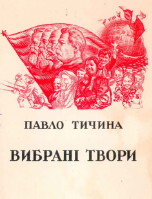
|
SOCIALIST REALISM. In its first period (1934-41) socialist realism's range in prose was restricted to depictions of industrialization and collectivization. Poetry was reduced to stilted odes to the Party and its leaders. During the Second World War literature was dominated by patriotic themes and publicistic style. Gradually the theme of glorification of the Russian 'big brother' crept in, and it was intensified after the war. The theme reached a climax in the 'unification celebrations' of 1954. Socialist realism's need to hide falsity of content gave rise to certain characteristics of style in all Soviet literature. It was responsible for the presence of compendiums of useless information and statistical data, the use of artificial verbal ornamentation, the overuse of epithets and similes (even in the works of superior writers, such as Oles Honchar and Pavlo Zahrebelny), a decline in the lexicon to the level of journalistic vocabulary, a reliance on artificial pathos that dipped into sentimentality (in the novels of Mykhailo Stelmakh), and a preponderance of didacticism and moralizing... |
| Socialist realism |
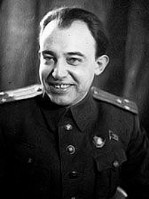
|
KORNIICHUK, OLEKSANDER, b 25 May 1905 in Khrystynivka, Kyiv gubernia, d 14 May 1972 in Kyiv. Dramatist and prominent Soviet Ukrainian political figure. In 1934 he became a member of the executive of the newly created Writers' Union of Ukraine. A protege of Joseph Stalin, he was promoted to numerous positions: deputy to the Supreme Soviet of the USSR (from 1937) and the Supreme Soviet of the Ukrainian SSR (from 1938); USSR deputy people's commissar of foreign affairs (1943); president of the Supreme Soviet of the Ukrainian SSR (1947-55, 1959-72); member of the Central Committe of the Communist Party of Ukraine (from 1949) and the Central Committee of the Communist Party of the Soviet Union (from 1952), etc. Korniichuk's first plays in the late 1920s attracted little attention. He garnered fame with his play about the Civil War, Zahybel' eskadry (The Destruction of the Squadron, 1933). His subsequent plays were formulaic and written in the style of socialist realism in conformity with the Party's political imperatives and propagandistic needs... |
| Oleksander Korniichuk |
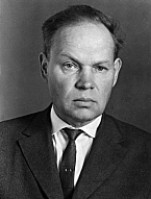
|
STELMAKH, MYKHAILO, b 24 May 1912 in Diakivtsi, Letychiv county, Podilia gubernia, d 27 September 1983 in Kyiv. Prose writer, poet, and dramatist. He graduated from the Vinnytsia Pedagogical Institute (1933) and taught in villages of the Kyiv district until 1939. After the war he was a deputy to the Supreme Soviet of the USSR and vice-chairman of the Council of Nationalities. His poetry was first published in 1936. From the 1940s he wrote mainly prose which represents a typical example of socialist realism. It shows the characteristic conformism to shifting Party policy (eg, the novel Velyka ridnia [Great Family] glorifies Joseph Stalin throughout and was awarded the Stalin prize in 1951; later, criticized for succumbing to the Stalinist 'personality cult,' Stelmakh completely rewrote it under the new title Krov liuds'ka - ne vodytsia [Human Blood Is Not Water, 1957]). The characteristic socialist-realist glossing over of Soviet reality is present in Stelmakh's work even of the post-Stalinist era... |
| Mykhailo Stelmakh |
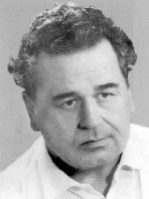
|
MALYSHKO, ANDRII, b 15 November 1912 in Obukhiv, Kyiv county, d 17 February 1970 in Kyiv. Poet and publicist. Malyshko's first published works appeared in 1930, and his first published collection of poetry was Bat'kivshchyna (The Fatherland, 1936). During the Second World War he was a correspondent of front-line newspapers and published several collections of patriotic poetry. His postwar material includes Za synim morem (Beyond the Blue Sea, 1950), Knyha brativ (The Book of Brothers, 1954), and numerous other collections. The references to internal and international politics and Communist Party directives throughout Malyshko's voluminous canon made him the recipient of various Soviet awards. His works were held out as models of socialist realism and lauded for their populism and adherence to the Party line. In accordance with the prime directive of socialist realism of 'creating for the people' he employed a simplistic lexicon and poetic form and concentrated on the sentimental and patriotic. Many of his works have been put to music... |
| Andrii Malyshko |
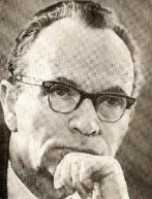
|
RYBAK, NATAN, b 3 January 1913 in Ivanivka, Yelysavethrad county, Kherson gubernia, d 11 September 1978 in Kyiv. Socialist-realist writer of Jewish origin. He began publishing in 1930 and produced 3 poetry collections in the 1930s and about 20 short story collections, most of them in the 1930s and 1940s. He is best known for his novels, some of which idealize Stalinist industrialization and the struggle with 'counterrevolution'; Dnipro (1937-8) depicts the revolutionary period in Southern Ukraine; Pomylka Onore de Bal'zaka (The Mistake of Honore de Balzac, 1940) portrays Honore de Balzac's stay in Ukraine, while Zbroia z namy (The Weapons Are with Us, 1943) is set in Ukraine during the Second World War. His Pereiaslavs'ka rada (The Pereiaslav Council, vol 1, 1948, for which Rybak was awarded a Stalin Prize in 1950; vol 2, 1953) is a major Soviet historical epic about the Cossack-Polish War, Hetman Bohdan Khmelnytsky, and the Pereiaslav Treaty of 1654. His later novels focus on the Cold War and plots from the lives of Soviet scientists... |
| Natan Rybak |
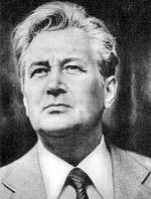
|
HONCHAR, OLES, b 3 April 1918 in Sukha, Kobeliaky county, Poltava gubernia, d 14 July 1995 in Kyiv. One of the most prominent Soviet Ukrainian writers of the postwar period; a full member of the Academy of Sciences of the Ukrainian SSR from 1978. A Second World War veteran and graduate of Dnipropetrovsk University, he began to publish his works in 1938. From 1959 to 1971 he headed the Writers' Union of Ukraine. Honchar gained prominence with the novel-trilogy Praporonostsi (The Standard Bearers, 1947-8) about the Red Army in the Second World War. His other works include such novellas as Zemlia hude (The Earth Drones, 1947); such novels as Tavriia (1952), Liudyna i zbroia (Man and Arms, 1960), and Sobor (The Cathedral, 1968), which was officially censured and subsequently removed from circulation; as well as short-story collections and three collections of literary articles. His works, most of which closely adhere to the official Soviet style of socialist realism, have been republished many times and have been the subject of a large body of Soviet literary criticism... |
| Oles Honchar |
The preparation, editing, and display of the IEU entries about socialist realism in Ukrainian literature were made possible by the financial support of the CANADIAN FOUNDATION FOR UKRAINIAN STUDIES.
 XVII. THE 'PRAGUE SCHOOL' AND UKRAINIAN NATIONALIST WRITERS OF THE INTERWAR PERIOD
XVII. THE 'PRAGUE SCHOOL' AND UKRAINIAN NATIONALIST WRITERS OF THE INTERWAR PERIOD
The term 'Prague school' of Ukrainian poets and writes is used to designate a substantial group of Ukrainian emigre literati, most of whom left Ukraine after the failed Ukrainian struggle for independence of 1917-21. Members of this group espoused nationalist ideology and grouped themselves around Dmytro Dontsov's journal Vistnyk, whether in Lviv (eg, Bohdan Kravtsiv), Prague (eg, Yurii Darahan, Oksana Liaturynska, Leonid Mosendz, Oleksa Stefanovych, Oleh Olzhych, and Olena Teliha), or Warsaw (eg, Yurii Lypa, Nataliia Livytska-Kholodna, and Yevhen Malaniuk). The group included some participants of the Ukrainian cultural renaissance of the 1920s, such as the neocalssicist Yurii Klen (Oswald Burghardt), but was primarily composed of younger writers many of whom were the UNR Army veterans. Their poetry, often written in regular meters and strophes and employing heroic imagery, as well as their prose were aimed chiefly at furthering the struggle for national liberation and expressed this generation's anger and frustration at Ukraine's subjugation by foreign powers and at the defeat of the struggle for independence. Their criticism was directed not only at external forces but also at Ukrainian internal weaknesses, such as the Little Russian mentality, anarchism, and lack of national discipline and organization. Most of these writers were actively involved in the Ukrainian nationalist movement and several of them, including Lypa, Olzhych, and Teliha, lost their lives fighting for independent Ukraine during the Second World War. Learn more about the Ukrainian emigre nationalist poets and writers of the interwar period by visiting the following entries:

|
LYPA, YURII, b 5 May 1900 in Odesa, d 20 August 1944. Writer and publicist. He was a graduate of Poznan University (1929) and a physician by profession. From 1920 he lived in Poland and Galicia. He died serving as a physician with the Ukrainian Insurgent Army. His poetry began to be published in 1919 and several collections of his poetic works appeared. In 1929, together with Yevhen Malaniuk, Lypa established the literary group Tank in Warsaw and became the group's main ideologist. His prose works include a novel, three volumes of short stories, and a collection of essays. He wrote a number of publicist works which were popular at the time and in which he outlined his so-called Black Sea doctrine; and numerous publicistic articles and essays of literary criticism. Lypa's 'imperial' concept was not well-founded but it was expounded in such a brilliant and stirring style that he became one of the most popular figures of his time in Galicia and among Ukrainian emigrants. His medical works were reprinted several times and enjoyed great popularity... |
| Yurii Lypa |
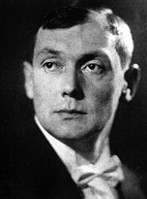
|
MALANIUK, YEVHEN, b 20 January 1897 in Novoarkhanhelsk, Olviopil county, Kherson gubernia, d 16 February 1968 in New York. Poet and political and community activist. He became an officer of the Army of the Ukrainian National Republic in 1917 and was interned in Kalisz, Poland, in 1920. He graduated from the Ukrainian Husbandry Academy in Podebrady in 1923. Toward the end of the Second World War he resettled in Germany, and then he emigrated to the United States. His poetry is one of the better examples of the literary resurgence of the 1920s and 1930s. He was a member of the vistnykivtsi, made up of literary contributors to Dmytro Dontsov's journal Vistnyk. His work was influential in emigre circles, in Western Ukraine, and in the Ukrainian Soviet Socialist Republic, where he was under constant attack by official critics. The style and engaged content of his poetry emerged as a result of his generation's anger and frustration at Ukraine's subjugation, at the defeat of the struggle for independence (1917-20), and at the ongoing tragedy caused by Moscow's domination of Ukraine... |
| Yevhen Malaniuk |
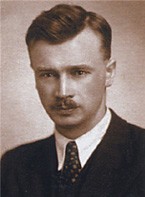
|
OLZHYCH, OLEH, b 8 July 1907 in Zhytomyr, Volhynia, d 9 June 1944 in the Sachsenhausen concentration camp. Archeologist, poet, and nationalist leader; son of Oleksander Oles. Olzhych emigrated from Ukraine in 1923 and lived in Prague, where he graduated with a degree in archeology from Charles University in 1929. After a brief lecture tour at Harvard University Olzhych helped found the short-lived Ukrainian Research Institute in America (Saint Paul, Minnesota) and edited its first collection of papers (1939). In 1929 Olzhych joined the Organization of Ukrainian Nationalists and headed its cultural and educational branch. After the split in the OUN in 1940, he went with the Melnykites. As second-in-command to Andrii Melnyk he represented the OUN leadership in Carpatho-Ukraine (1938-9) and took part in forming the Ukrainian National Council in 1941. Until his arrest and execution by the Gestapo, he directed Melnykite underground activities in Ukraine. Often relying on historical themes to illustrate the inalienable right of Ukraine to independent statehood, Olzhych's verse typifies the nationalist poetry between the two world wars... |
| Oleh Olzhych |
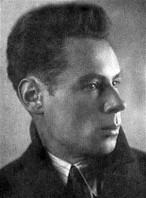
|
STEFANOVYCH, OLEKSA, , b 5 October 1899 in Myliatyn, Ostrih county, Volhynia gubernia, d 4 January 1970 in Buffalo, New York. Poet. As an interwar emigre he studied at Prague University (1922-8; PH D diss on Amvrosii Metlynsky as a poet, 1932) and the Ukrainian Free University (1928-30). His poetry appeared in Ukrainian journals in Prague, Lviv, and Chernivtsi and was published in Prague in two collections. Although Stefanovych belonged to the 'Prague school' of Ukrainian poets, the voluntarism characteristic of the works of its other members is absent in his poems. His creativity was inspired by elegiac memories of Volhynia's landscapes, by Ukrainian historical and mythological figures, and by tragic events in Ukraine's past and present. Paganism (with erotic overtones) and, in his later poems, Christianity (often of the mystical variety) were dominant forces in his oeuvre. His style is notable for the originality of his poetic language, with its archaisms, neologisms, and unique use of syntax... |
| Oleksa Stefanovych |
The preparation, editing, and display of the IEU entries featuring the 'Prague school' of the interwar Ukrainian nationalist poets and writers were made possible by the financial support of the MICHAEL KOWALSKY AND DARIA MUCAK-KOWALSKY ENCYCLOPEDIA ENDOWMENT FUND at the Canadian Institute of Ukrainian Studies (Edmonton, AB, Canada).
 XVIII. THE 'MINOR RENAISSANCE' OF UKRAINIAN LITERATURE IN THE 1940s
XVIII. THE 'MINOR RENAISSANCE' OF UKRAINIAN LITERATURE IN THE 1940s
Immediately after World War II, in the second half of the 1940s, Ukrainian literature outside of Soviet Ukraine experienced an unusually intensive period of development in the displaced persons' camps in western Germany and Austria. These camps, which had become home to over 200,000 Ukrainian war refugees, including a significant number of writers and literary scholars, represented a hub of fervent cultural activity, so much so that the period 1945-1949 is often referred to by scholars as the 'minor renaissance' of Ukrainian literature. Thrown together from various regions of Ukraine, writers managed to replay on a small scale the activity of the 1920s. They convened congresses, organized literary associations, and published almanacs, journals, and books. A key role in the period's most important literary organization, MUR, was played by the linguist, scholar, and literary critic, George Yurii Shevelov and the novelist Ulas Samchuk. Other most notable members of MUR included the dramatist, prose writer, essayist, and publisher Ihor Kostetsky; the writer and scholar Viktor Petrov (V. Domontovych), the politically ambivalent Yurii Kosach, and the poet Vasyl Barka. This 'minor renaissance' of Ukrainian literature came to an end in the early 1950s as the majority of the authors emigrated to North America and continued their literary work there... Learn more about the Ukrainian literature written in the 1940s in the displaced persons' camps by visiting the following entries:
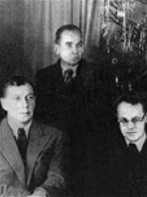
|
MUR. (Mystetskyi ukrainskyi rukh [The Artistic Ukrainian Movement]). An artistic-literary organization of Ukrainian emigres in Europe. It was founded on 25 September 1945 in Furth, Germany, on the initiative of a committee consisting of Ivan Bahriany, V. Domontovych (Viktor Petrov), Yurii Kosach, Ihor Kostetsky, Ivan Maistrenko, and Yu. Sherekh (George Yurii Shevelov). MUR organized three writers' congresses (1945, 1947, and 1948) as well as three conferences devoted to various aspects of literary activity. The head of the organization during its whole duration was Ulas Samchuk, and its membership numbered 61. The objectives of MUR were to gather Ukrainian writers scattered by the Second World War, to organize the publication of their works, and to become a center for creative dialogues among members representing various styles and literary aims. MUR managed to organize almost all of the noted emigre writers and provide them with a forum for discussion while it stimulated an interest in literature among the public at large... |
| MUR |
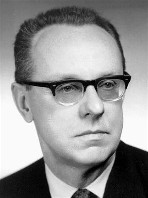
|
SHEVELOV, GEORGE YURII (pseud: Yurii Sherekh), b 17 December 1908 in Kharkiv, d 12 April 2002 in New York. Slavic linguist, philologist, essayist, literary historian, and literary critic; full member of the Shevchenko Scientific Society since 1949 and of the Ukrainian Academy of Arts and Sciences since 1945. After studying under Leonid Bulakhovsky at Kharkiv University (candidate 1939) he lectured there in Slavic linguistics (1939-43). Having emigrated to Germany, he taught at the Ukrainian Free University in Munich (1946-9) and obtained a doctorate there (1949). He was also vice-president of the MUR literary association (1945-9). After settling in the United States he served as lecturer in Russian and Ukrainian at Harvard University (1952-4), associate professor (1954-8) and professor of Slavic philology at Columbia University (1958-77), and president of the Ukrainian Academy of Arts and Sciences (1959-61, 1981-6). He was a founding member of the Slovo Association of Ukrainian Writers in Exile... |
| George Yurii Shevelov |
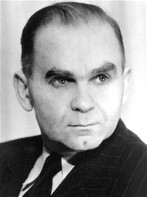
|
SAMCHUK, ULAS, b 20 February 1905 in Derman, Ostrih county, Volhynia gubernia, d 9 July 1987 in Toronto. Writer and journalist. Samchuk was educated at the University of Breslau (now Wroclaw, Poland) and at the Ukrainian Free University in Prague (1931). His literary career began in 1926. He was editor of the Rivne newspaper Volyn' (1941-3), and he fled to Germany in 1944, where he headed the literary-artistic organization MUR (1945-8). He emigrated to Canada after 1948 and became a longtime head of the Slovo Association of Ukrainian Writers in Exile. Samchuk's prose is deeply rooted in the 19th-century realist tradition. His novels are broad-canvas chronicles of the Ukrainian experience in the 20th century. Themes progress from the difficult national and cultural nascence in the trilogy Volyn' (Volhynia, 1932, 1935, 1937), the devastating Ukrainian Famine-Genocide of 1932-33 in Mariia (1934), and the Second World War and forced Ukrainian labor in the trilogy Ost (East, 1948, 1957, 1982)... |
| Ulas Samchuk |
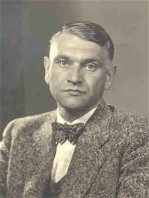
|
KOSTETSKY, IHOR (Kostetzky, Eaghor G.; pen name of Ihor Merzliakov), b 14 May 1913 in Kyiv, d 14 June 1983 in Schwaikheim, West Germany. Writer, playwright, translator, critic, and publisher. He grew up in Kyiv and Vinnytsia. In the 1930s he studied stage directing and acting in Leningrad and Moscow. A postwar refugee in Germany, he was one of the founders of the writers' association MUR. In the 1950s and 1960s he edited an illustrated journal Ukraina i svit. He and his wife, the German poet Elizabeth Kottmeier, established the Na Hori publishing house in the mid 1950s and, over the period of twenty five years, published several dozen books, including some outstanding editions of the world literary classics in the Ukrainian translation. Kostetsky published prolifically during the late 1940s. His prose works combined traditional and modernist (expressionist, surrealist, dadaist) forms of expression. His experimental plays written in the 1940s anticipated many stylistic devices subsequently mastered by such dramatists as Samuel Beckett... |
| Ihor Kostetsky |
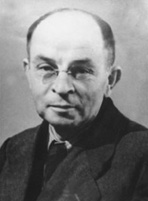
|
PETROV, VIKTOR (pseud: V. Domontovych, V. Ber), b 22 October 1894 in Katerynoslav (now Dnipropetrovsk), d 8 June 1969 in Kyiv. Writer, literary scholar, archeologist, and ethnographer; member of the Shevchenko Scientific Society. A graduate of Kyiv University (1918), from 1920 he worked for the Ethnographic Commission of the All-Ukrainian Academy of Sciences. During the 1920s he also worked as a literary scholar and writer and was close to the Neoclassicists. In 1941 he was briefly director of the Institute of Ukrainian Folklore of the Academy of Sciences of the Ukrainian SSR. In 1944 he fled to the West. As a refugee in postwar Munich he was a professor at the Ukrainian Free University and a member of the editorial boards of the literary and art monthly Arka and the MUR collections. In 1949 he 'reappeared' in the USSR and worked at the USSR Academy of Sciences in Moscow. From 1956 he was a senior associate of the Institute of Archeology of the Academy of Sciences of the Ukrainian SSR in Kyiv and the custodian of its scientific archive... |
| Viktor Petrov |
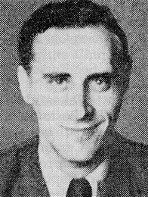
|
KOSACH, YURII, b 5 December 1909 in Kyiv, d 10 January 1990 in Passaic, New Jersey. Poet, writer, and dramatist; nephew of Lesia Ukrainka. Kosach studied at Warsaw University and in Paris. After the war he lived in displaced persons camps in Germany and was an active member of the writers' organization MUR. In 1949 he immigrated to the United States. While in New York he began publishing a pro-Soviet journal, Za synim obriiem, which was notable primarily for its strident anti-emigre attacks. A prolific author excelling in the genre of the historical novel, he is also the author of several collections of rather average poetry, often marked by his interest in history and mythology. His dramatic works include Obloha (The Siege, 1943)--a dramatic poem--and the tragedy Diistvo pro Iuriia Peremozhtsia (Play about Yurii the Conqueror, 1947). By far the largest and most interesting body of work is Kosach's prose, written prior to his emigration to the United States... |
| Yurii Kosach |
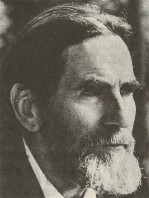
|
BARKA, VASYL (pseud of Vasyl Ocheret), b 16 July 1908 in the village of Solonytsia near Lubni, Poltava gubernia, d 11 April 2003 in Liberty, New York State. Poet, writer, literary critic, translator. An emigre from 1943, he lived in Germany, where he was active in the MUR literary association, before settling in the United States in 1949. Barka's orphic works require intuitive rather than logical comprehension. His poetry developed and grew in stature, from the early lyrical collections to the monumental 4,000-strophe epic novel in verse Svidok dlia sontsia shestykrylykh (The Witness for the Sun of Seraphims, 1981), addressed to the theme of reconciliation between 'man and the Creator.' His first novel, Rai (Paradise, 1953), deals with the Soviet 'paradise.' His second novel, Zhovtyi kniaz' (The Yellow Prince, 1962, 1968), about the Ukrainian Famine-Genocide of 1932-33, was translated into French (Paris 1981) and served as the basis for Oles Yanchuk's 1993 Ukrainian feature film Holod-33 (Famine-33)... |
| Vasyl Barka |
The preparation, editing, and display of the IEU entries featuring the Ukrainian literature's 'minor renaissance' in the 1940s were made possible by the financial support of the CANADIAN FOUNDATION FOR UKRAINIAN STUDIES.
 XIX. THE NEW YORK GROUP AND POSTWAR EMIGRE MODERNIST LITERATURE
XIX. THE NEW YORK GROUP AND POSTWAR EMIGRE MODERNIST LITERATURE
In the mid-1950s, a new generation of Ukrainian emigre poets and writers appeared in the West to complement the older generation of Ukrainian literary figures who left both Soviet and Western Ukraine during the Second World War. Eager to modernize Ukrainian literature, the most prominent of these young literati, who established an informal New York Group, rejected the nationalist poetry of their predecessors and were searching for a new synthesis and expression capable of absorbing their peculiar situation as permanent emigres. The New York Group was never united by any artistic credo or manifesto. More a grouping of friends than an organization, it embraced Ukrainians who began their period of creativity in North America, who happened to be living (in most cases, only temporarily) in New York. In form their poetry ranged from the surrealism of Emma Andiievska and the depoeticized verse of George Tarnawsky to the more traditional quatrains of Bohdan Boychuk, Bohdan Rubchak, and Vira Vovk although most of the members of the initial group had experienced similar influences (Jean-Paul Sartre, Federico Garcia Lorca, Albert Camus, Franz Kafka, Pablo Neruda), had a common emigre heritage, which at times encouraged in them a preoccupation with the purity of the Ukrainian language, and were united in a desire to distance themselves from the overly nationalistic poetry of the previous generation. Their creativity provided a much-needed revitalization of the emigre Ukrainian literature after the war and probably served also as an impetus for the shistdesiatnyky poets in Ukraine and, more notably, for the next generation of poets, including the so-called Kyiv School... Learn more about the New York Group and postwar Ukrainian emigre modernist writers by visiting the following entries:
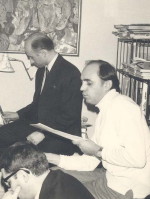
|
NEW YORK GROUP. A group of poets and artists, which developed spontaneously in the mid-1950s from informal friendships and discussions around the Students'ke slovo (Student Word) supplement to the newspaper Svoboda. The initiating core consisted of Bohdan Boychuk and George Tarnawsky. In 1954 the group grew to include, for some time, several Ukrainian artists, such as Bohdan Pevny, Yaroslava Gerulak, and Jurij Solovij. It organized art exhibitions and poetry readings. Five other poets joined Boychuk and Tarnawsky in the late 1950s to form the core of the initial New York Group: Bohdan Rubchak, Zhenia Vasylkivska, Emma Andiievska, Patritsiia Kylyna (Patricia Warren), and Vira Vovk. The name New York Group, chosen because its most active members lived in the New York area, was applied to the group from 1958, when they decided to start a serial publication, Novi poezii. The name was also used for a publishing house, which published many of the collections of the individual members. In 1965 three other poets, Yurii Kolomyiets, Oleh Koverko, and Marco Carynnyk, published their poems in Novi poezii and became associated with the group. In 1969 the group grew to include Roman Baboval from Belgium. Following a period of inactivity in the 1970s, the group was revitalized in 1984-85 and joined by Maria Rewakowicz. Between 1990 and 1999 Boychuk and Rewakowicz, in cooperation with the Writers' Union of Ukraine, published a literary journal Svito-vyd in Kyiv... |
| New York Group |
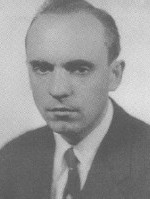
|
BOYCHUK, BOHDAN, b 11 October 1927 in the village of Bortnyky, Buchach county, Galicia. Poet, cofounder and member of the New York Group, writer, literary critic, and translator. An Ostarbeiter in Nazi Germany and postwar refugee, he lived in displaced persons camps in Germany until 1949, when he immigrated to the United States and settled in New York. An active member of the Ukrainian emigre cultural community, he was cofounder and coeditor of the New York Group's serial publication Novi poezii and the main organizer of the group's publishing house. He was also an editor of literature (between 1961 and 1973) of the journal Suchasnist', and a cofounder and coeditor of the literary journal Svito-vyd in Kyiv (1990-99). Boychuk published numerous collections of modernist poetry, strongly influenced by the philosophy of Existentialism. His is also an author of several novels and prose collections, a collection of drama, and a book of memoirs. Boychuk has translated Spanish and American poetry into Ukrainian, Ukrainian poetry (the poetry of Bohdan Ihor Antonych and Ivan Drach) into English, and has edited several anthologies and books of Ukrainian poetry (including collected works of Oleksa Stefanovych and Bohdan Kravtsiv), memoirs (of the actor and theater director Yosyp Hirniak), and books on Ukrainian emigre artists...
|
| Bohdan Boychuk |
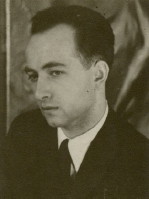
|
TARNAWSKY, GEORGE, b 3 February 1934 in Turka, Sambir county, Galicia. Linguist, poet, novelist, and translator. Tarnawsky was displaced by the Second World War, and grew up in a displaced persons camp in Neu Ulm, Germany. He emigrated to the United States in 1952 and completed a degree in electrical engineering and then turned to linguistics, in which discipline he was awarded a PH D from New York University in 1982. He worked at IBM on automated language-translation projects and artificial intelligence and published a number of scientific papers on those subjects. In his early poetry Tarnawsky was influenced by the French pre-Symbolists and Surrealists, as well as modern Spanish-language poets and by the philosophy of Existentialism. His linguistic studies and computer work have had a profound influence on him as a writer. In his poetry as well as in his prose he has eschewed the more usual embellished language and has sought the utmost semantic and syntactic directness, as if his creations were to enter into a one-to-one computerized relationship between word and meaning. Tarnawsky is unique in his expression, and his poems reflect well the mechanized and dehumanized contemporary world. He has published several collections of verse and Ukrainian-language prose as well as a book of drama. He is also the author of English-language prose works. Tarnawsky was the cofounder and editor of the group's periodic publication Novi poezii (1959-71)... |
| George Tarnawsky |
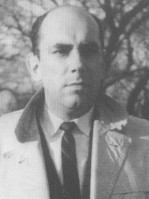
|
RUBCHAK, BOHDAN, b 6 March 1935 in Kalush, Galicia. Poet and literary scholar. In 1948, after being displaced by the Second World War, Rubchak settled in the United States. He studied comparative literature at Rutgers University in New Jersey (PH D, 1977) and between 1974 and 2005 was a professor at the University of Illinois, Chicago Circle. A member of the New York Group, Rubchak published five collections of poetry and a volume of collected works. His lyrical poetry is introspective and marked by classical restraint and an intellectual atmosphere enhanced by his literary erudition. His short stories are gifted but too sporadic, and his prose consists mainly of literary criticism. Numerous essays in both English and Ukrainian have appeared in various journals and reveal that he is a very knowledgeable, incisive, and eloquent critic of Ukrainian poetry, individual poets, modernism, and emigre Ukrainian literature. Of special note are his comprehensive introduction to Ukrainian modernism in the book of works by Ostap Lutsky, his annotations of and introduction to Mykhailo Kotsiubynsky in the translation of Shadows of Forgotten Ancestors (1981), and his notes to the edition of collected works by Bohdan Ihor Antonych (1967). Together with Bohdan Boychuk he edited and wrote biographical-critical vignettes for the important two-volume anthology of contemporary Ukrainian poetry in the West Koordynaty (Co-ordinates, 1969)... |
| Bohdan Rubchak |
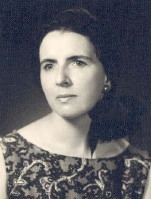
|
VOVK, VIRA (pseudonym of Vira Selianska), b 2 January 1926 in Boryslav, Drohobych county, Galicia. Writer, literary scholar, and translator. Having been forced to emigrate by the Second World War, Vovk studied German language and literature in Germany, at Tubingen University and Munich University (1945-9), and completed her studies with a doctorate in 1950 at the Catholic University of Rio de Janeiro, Brazil, where she remained as a lecturer and, in 1968-80, professor of comparative literature. From 1980 she taught at the Federal University in Rio de Janeiro. Vovk writes in three genres: poetry, prose, and drama. The most voluminous is her poetic output. Her poetry, which began as often derivative, formally unsophisticated lyricism, developed in her later collections into the highly complex and rhythmical free verse of her 'elegies' and the intricate multirhythms of her 'ballads', in which she mixes dialogue with narration and bilingual texts. Two major motifs flow through her poetry, exotic geography (the result of displacement) and religious mysticism. The interest in mysticism and myth carries over into her less-voluminous prose and her poetic drama. Many of her publications, from the 1970s on, are exquisite esthetic productions with hand-inserted illustrations by Ukrainian artists or Vovk's own paper cutouts. Vovk has devoted a great deal of time to translation into Ukrainian and into Portuguese and German... |
| Vira Vovk |
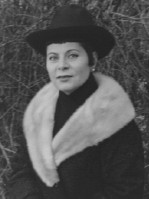
|
ANDIIEVSKA, EMMA (or ANDIJEWSKA), b 19 March 1931 in Staline (now Donetsk). Poetess, prose writer, and painter. An emigre since 1943, she at first lived in Germany, then in France and the United States, and now again lives in Germany. Initially associated with the New York Group of poets, Andiievska later distanced herself from the group. Andiievska's work is highly original. To date she has published nearly thirty collections of verse, five collections of short prose, and three novels. The reaction of literary critics to Andiievska's works has been mixed and even contradictory. Very highly praised by prominent literary scholars, she was harshly criticised by others who attacked her work for its incomprehensibility. The hermeticism of her poetry (in particular, her complex and non-traditional sonnets with consonant rhymes) and the self-imposed and strictly adhered-to structural constraints of her prose do not lend themselves to easy comprehension. Andiievska's poetic world consists of surrealistic landscapes rooted in real descriptions of nature, which the poet views from various dimensions and to which she provides exquisite instrumentation. The multidimensional imagery produces an effect of simultaneity of events, coinciding with the notion of 'round time', whose laws govern her multiepisodic but monolinear (chainlike) novels. Andiievska's poetry is often meditative and metaphysical in its imagery, exhibiting elements of surrealism and affinity to Far Eastern philosophical doctrines, such as Zen Buddhism... |
| Emma Andiievska (Andijewska) |
The preparation, editing, and display of the IEU entries about the New York Group and postwar Ukrainian emigre modernist writers were made possible by the financial support of the CANADIAN FOUNDATION FOR UKRAINIAN STUDIES.
 XX. SHISTDESIATNYKY: THE LITERARY GENERATION OF THE POST-STALINIST THAW IN UKRAINE
XX. SHISTDESIATNYKY: THE LITERARY GENERATION OF THE POST-STALINIST THAW IN UKRAINE
After the death of Joseph Stalin in 1953 and the 'de-Stalinization' speech by Nikita Khrushchev in 1956, the controls over literature in the Soviet Union began to slacken. The film director Oleksander Dovzhenko initiated the post-Stalinist 'thaw' in Ukrainian literature with the publication of his autobiographical novelette Zacharovana Desna (The Enchanted Desna, 1957). The process of rehabilitation of some of the authors destroyed in the 1930s began slowly. The rediscovery of the 1920s had a profound influence on the generation that was born just before or during the Second World War and began publishing in the 1960s. The so-called shistdesiatnyky (the Sixtiers) succeeded in a span of 10 years in revitalizing all genres of Soviet Ukrainian literature. Characteristic of shistdesiatnyky poetry was the renewal of poetic forms and subjects, which had been stamped out by the dogma of socialist realism. The prose of the group was characterized by realistic descriptions free of the constraints of socialist realism, witty humor or sharp satire, subtle delineation of the motives of protagonists, and an interest in historical subjects. However, the shistdesiatnyky movement lasted barely a decade. The writers concerned were harshly criticized and then completely silenced by the arrests of 1965-72. During the course of those repressions some individual writers went over to the official position without having offered particular resistance; some of them were denied permission to publish, or refused to do so for some time; others, who continued to oppose national discrimination and Russification and joined the ranks of the Ukrainian dissident movement, were arrested and punished with long prison sentences... Learn more about the shistdesiatnyky by visiting the following entries:
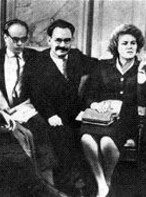
|
SHISTDESIATNYKY (also Shestydesiatnyky; The Sixtiers). The literary generation that began to publish in the second half of the 1950s, during Nikita Khrushchev's 'de-Stalinization,' and reached their literary peak in the early 1960s; hence, their name. The first representatives were Lina Kostenko and Vasyl Symonenko. Following their lead came a veritable proliferation of poets: Ivan Drach, Mykola Vinhranovsky, H. Kyrychenko, Vasyl Holoborodko, Ihor Kalynets, B. Mamaisur, and others. At first Vitalii Korotych was close to the group. The more prominent prose writers were Valerii Shevchuk, Hryhir Tiutiunnyk, Volodymyr Drozd, Yevhen Hutsalo, and Yaroslav Stupak, and literary critics, Ivan Dziuba, Yevhen Sverstiuk, Ivan Svitlychny, and I. Boichak. The shistdesiatnyky held their 'literary parents' responsible for Stalinist crimes, for adapting to a despotic regime, and for creative impotence (eg, Drach in 'Oda chesnomu boiahuzovi' [Ode to an Honest Coward]). In turn, some of the older writers, such as Pavlo Tychyna, Platon Voronko, Mykola Sheremet, and Mykhailo Chabanivsky, exhibited a hostile attitude to the experimentation and innovation of the shistdesiatnyky... |
| Shistdesiatnyky |
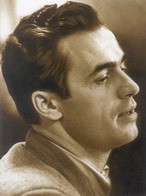
|
SYMONENKO, VASYL, b 8 January 1935 in Biivtsi, Lubny raion, Poltava oblast, d 13 December 1963 in Cherkasy. Poet, journalist, and dissident. He graduated with a degree in journalism from Kyiv University in 1957. Symonenko began writing poetry while a student, but because of the harsh environment of Soviet censorship he published little. Only one collection of his poetry appeared during his lifetime, Tysha i hrim (Silence and Thunder, 1962). His poetry, however, was popular and was widely circulated in samvydav, and it largely marks the beginning of the Ukrainian opposition movement of the 1960s and 1970s. Thematically, his verse consists of satires on the Soviet regime, descriptions of the difficult life of the peasantry, condemnations of Soviet despotism, and protestations against Russian chauvinism. Of particular importance is a cycle of poems in which the poet speaks of his love for Ukraine. In the first decade following Symonenko's death Soviet literary criticism attempted to paralyze the influence of his samvydav poetry, by suppressing it and simultaneously praising it as 'irreproachably devoted to the Communist Party line...' |
| Vasyl Symonenko |
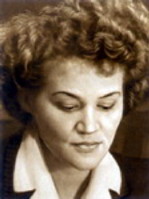
|
KOSTENKO, LINA, b 19 March 1930 in Rzhyshchiv, Kyiv oblast. Poet; one of the earliest and most outstanding of the shistdesiatnyky. Her first poems were published in the early 1950s. She published three poetry collections by 1961. Her collection 'Zorianyi integral' (The Stellar Integral) was ready for publication in 1962, but the censors judged it ideologically harmful and a departure from socialist realism and suppressed it. In 1965 and 1968 Kostenko signed several open letters protesting the arrests and secret trials of Ukrainian intellectuals. Her poetry was not published in Ukraine again until 1977, when her collection Nad berehamy vichnoi riky (On the Banks of the Eternal River) appeared. A novel in verse, Marusia Churai (1979) and the collection Nepovtornist' (Uniqueness, 1980) followed and earned its author the Shevchenko Prize in 1987. In 1987 Kostenko published her next collection Sad netanuchykh skul'ptur (Garden of Unthawed Sculptures). Her historical novel in verse Berestechko, originally composed in 1966, appeared in book form only in 1999. Kostenko's poetry consists primarily of intimate, lyric poems and 'social' poems on the role and responsibility of a poet, particularly in a totalitarian society...
|
| Lina Kostenko |
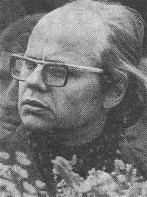
|
DRACH, IVAN, b 17 October 1936 in Telizhyntsi, Kyiv oblast. Poet, screenwriter, and political leader. Drach studied at Kyiv University (1958-61) and completed advanced scriptwriting courses in Moscow in 1964. His works have appeared in print since 1959. Drach stood at the forefront of the Ukrainian literary revival initiated by the shistdesiatnyky. His early poetry was noted for its originality, fresh imagery, complex metaphors, philosophical meditation, neologisms, and varied rhythm. He was criticized sharply for his departure from the canons of socialist realism, especially in the poem 'Nizh u sontsi' (Knife in the Sun, 1961), and for the satirical poem 'Oda chesnomu boiahuzevi' (Ode to an Honest Coward, 1963). He compromised with the regime in the late 1960s, and this proved detrimental to the quality of his later work. In the 1970s and 1980s he traveled abroad as an official Soviet cultural emissary. In the late 1980s Drach emerged as a prominent political activist in Ukraine. As head of the Kyiv organization of the Writers' Union of Ukraine he was instrumental in forging the coalition that created the Popular Movement of Ukraine (Rukh)... |
| Ivan Drach |
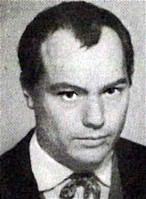
|
VINHRANOVSKY, MYKOLA, b 7 November 1936 in Bohopil, now part of Pervomaisk (Mykolaiv oblast), d 26 May 2004 in Kyiv. Writer, actor, film director, and translator. He graduated from the All-Union Institute of Cinematography (1960) in Moscow and has worked at the Kyiv Artistic Film Studio, where he played the lead role in Yuliia Solntseva's film Povist' polumianykh lit (The Tale of Flaming Years, 1961). He wrote film scripts and directed the feature films Eskadra povertaie na zakhid (The Squadron Turns Westward, 1967), Bereh nadii (The Shore of Hope, 1967), Duma pro Brytanku (Duma about Brytanka, 1969), and Klymko (1984) and several documentaries. Vinhranovsky gained prominence in the early 1960s as a leading poet of the shistdesiatnyky. He published nine poetry collections, several books of short stories, the novel Nalyvaiko (1991), and, from 1970, several poetry books for children, for which he was awarded the Shevchenko Prize in 1984... |
| Mykola Vinhranovsky |
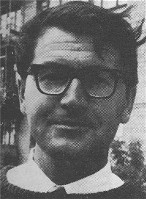
|
DZIUBA, IVAN, b 26 July 1931 in Mykolaivka, Volnovakha raion, Donetsk oblast. Literary scholar, publicist, and a former Ukrainian dissident and government minister; full member of the National Academy of Sciences of Ukraine (NANU) since 1992. Dziuba was one of the spokespersons of the shistdesiatnyky and expressed the aspirations of the postwar generation of Soviet Ukrainian writers to revitalize Ukrainian literature and liberate it from the influence of Russian literature. In the 1960s he became active in the movement against Russification and the persecution of the Ukrainian intelligentsia. Late in 1965 he completed his main work, Internatsionalizm chy rusyfikatsiia? (Internationalism or Russification?). In it he demonstrated how the Soviet regime had departed from the theoretical principles of Leninist nationality policy and had been Russifying Ukraine and destroying its society and intelligentsia under the pretext of internationalism. In January 1972 Dziuba was arrested and later sentenced to five years' imprisonment; he was released after he wrote a public recantation of his views...
|
| Ivan Dziuba |
The preparation, editing, and display of the IEU entries featuring the literary legacy of the shistdesiatnyky were made possible by the financial support of the CANADIAN FOUNDATION FOR UKRAINIAN STUDIES.
 XXI. UKRAINIAN DISSIDENT WRITERS OF THE 1960s TO 1980s
XXI. UKRAINIAN DISSIDENT WRITERS OF THE 1960s TO 1980s
The dissident movement came into existence in the USSR after the death of Joseph Stalin. It protested against violations of the law by organs of the state and demanded national and human rights. In Ukraine, as in other republics of the USSR where national oppression was keenly felt, the dissident movement represented a struggle against the violation of the republic's rights of sovereignty by the central government and the Communist Party, a resistance to colonization by foreign elements, and a protest against the destruction of cultural monuments, the falsification of the history of Ukraine, and generally against the policies of Russification. In Ukraine de-Stalinization saw the emergence in the 1960s of young and talented prose writers, poets, artists, and intellectuals known as the shistdesiatnyky. As harbingers of the idea of creative freedom, these individuals became symbols of the Ukrainian national renaissance. However, dissident activities in Ukraine constantly elicited repressive measures on the part of the regime. The first extensive wave of arrests and trials took place in 1965-6. The second wave occurred between January and April 1972, when many of the prominent shistdesiatnyky writers, scholars, and artists who refused to conform to the government pressure and accept the strictures of Communist Party control were arrested and imprisoned. They included Yevhen Sverstiuk, Ivan Svitlychny, Nadiia Svitlychna, Mykhailo Osadchy, Mykola Horbal, Nina Strokata, Vasyl Stus, Stefaniia Shabatura, Ihor Kalynets, Iryna Kalynets, and many others. They were tried for 'anti-Soviet agitation and propaganda' and given harsh prison sentences. Banned by the Party censorship, their literary works could appear only in the illegal samvydav (samizdat) editions or be smuggled abroad and published by emigre publishing houses. Most dissident writers were active in protests and hunger strikes in the Soviet prison camps; many became members of the Ukrainian Helsinki Group whose purpose was to monitor the implementation of the human rights provisions of the Helsinki Accords, signed in August 1975: freedom of conscience, the free flow of information, and freedom of travel. Some writers, including the prominent poet Vasyl Stus, died in a prison camp of the Gulag... Learn more about the Ukrainian dissident writers of the 1960s to 1980s by visiting the following entries:
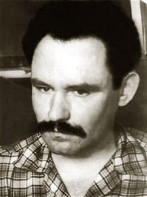
|
SVITLYCHNY, IVAN, b 20 September 1929 in Polovynkyne, Luhansk okruha, d 25 October 1992 in Kyiv. Poet, literary critic, human rights activist, and dissident. After graduating in philology from Kharkiv University in 1952, he worked as an editor of the journal Radians'ke literaturoznavstvo, a research associate of the Institute of Literature of the Academy of Sciences of the Ukrainian SSR, and a researcher in the dictionary department of the Institute of Linguistics of the Academy of Sciences of the Ukrainian SSR. In 1965 he was fired from his job and arrested for his 'nationalistic' activities, namely, smuggling abroad Vasyl Symonenko's poems. After eight months in prison he was released. In 13 January 1972 he was arrested for contributing to and distributing samvydav literature and was sentenced to seven years' hard labor and five years' internal exile. He was seriously ill in labor camp and suffered two strokes during exile. Upon his release in 1984 he returned to Kyiv permanently crippled. Svitlychny's critical articles began to appear in journals when he was still a student. In his early works on literary theory he rejected the application of philosophical concepts to the study of esthetics and literature. He was closely identified with the shistdesiatnyky in the 1960s, and devoted much attention to their work. He translated Czech, Slovak, and French poetry and Slovo o polku Ihorevi into Ukrainian. During imprisonment and exile he wrote poetry, some of which has appeared in the West... |
| Ivan Svitlychny |
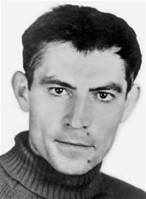
|
STUS, VASYL, b 8 January 1938 in Rakhnivka, Haisyn raion, Vinnytsia oblast, d 4 September 1985 in Soviet strict-regime concentration camp no. 389/36-1, Perm oblast, RSFSR. Dissident poet. Stus studied at the Donetsk Pedagogical Institute and began his graduate work at the Institute of Literature of the Academy of Sciences of the Ukrainian SSR in 1964. A year later, because of his protests against the secret arrests and closed trials which were becoming prevalent, he was expelled from the institute, and in 1972 he was arrested. He was sentenced to five years of strict-regime labor camp followed by three years of exile. While in exile he joined the Ukrainian Helsinki Group, and for that he was rearrested in 1980 and sentenced to 10 years of strict-regime labor camp and 5 years of exile. A man of uncompromising principles, Stus refused to kowtow to the regime and was subjected to constant persecutions, which finally were responsible for his death. Stus began writing poetry as a student. Because of his activities in the dissident movement, his first collection of poems was not printed. Although he continued to write while he was incarcerated, the KGB systematically confiscated and destroyed his work. Up to 600 poems and translations were destroyed in 1976. Some poems miraculously survived and were smuggled out to the West, where Stus's poetry appeared in several collections. Traditional in form, Stus's poetry began as 'lyricism of actuality.' His poetry written behind bars, however, is more meditative and philosophical; it expresses a longing, philosophical contemplation of life, nature, man the prisoner, and man the jailer, and reveals Stus's attempt to come to some synthesis with respect to the contradictions of the human experience...
|
| Vasyl Stus |
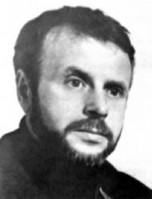
|
OSADCHY, MYKHAILO, b 22 March 1936 in Kurmany, now in Nedryhailiv raion, Sumy oblast, d 5 July 1994 in Lviv. Poet, writer, and dissident; honorary member of the Swiss section of the PEN International Association of Poets, Playwrights, Editors, Essayists, and Novelists from 1979. He graduated with a degree in journalism from Lviv University (1958), where he taught (1960-5) and then completed postgraduate studies (1965). He became active in the Ukrainian dissident movement in the mid-1960s. Osadchy was arrested in 1965 for anti-Soviet activity and sentenced in 1966 to two years' imprisonment. In 1972 he was arrested again and sentenced to seven years of strict-regime labor camp and three years of exile. He served his term in concentration camps in the Mordovian Autonomous Republic and was exiled to the Komi ASSR. His first collection of poetry, Misiachne pole (The Moonlit Field, 1965), was published before his arrest. His works were subsequently proscribed in the Ukrainian SSR, but his account of life in Soviet prisons, Bil'mo (Cataract, 1971), was published in the West and was translated into English (1976), French, and German. Other collections of his poetry include Quos ego (1979) and Skyts'kyi oltar (The Scythian Altar, 1990). Osadchy returned to teaching at Lviv University in the fall of 1990, and in the spring of 1992 he became a member of the Writers' Union of Ukraine. In 1993 Yrii (Warm South Regions) the first book of his poetry to be published in Ukraine, appeared in Lviv. Mykola Kholodny's biography of Osadchy appeared in 1996 and in 2001 a collection of the poet's scholarly and journalistic works was published as Ukrainotsentryzm (Ukrainocentrism)... |
| Mykhailo Osadchy |
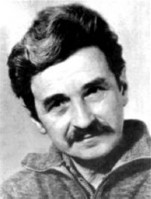
|
SVERSTIUK, YEVHEN, b 13 December 1928 in Siltse, Volodymyr-Volynskyi county, Volhynia, d 1 December 2014 in Kyiv. Literary and social critic, publicist, and political prisoner. He did graduate work at the Institute of Psychology in Kyiv and Odesa University and worked as a teacher in Ternopil oblast and the Poltava Pedagogical Institute. From 1959 he published articles and reviews in Soviet literary periodicals. Because of his criticism of Russification and other injustices, in 1965 he was blacklisted and dismissed from his job at the Kyiv Pedagogical Institute. Thenceforth his essays were circulated in Ukrainian samvydav and published in emigre periodicals. He was arrested in January 1972 and sentenced in March 1973, together with Ivan Svitlychny, for his involvement in the dissident movement and his defense of political prisoners, to seven years in strict-regime labor camps in Perm oblast and five years' exile in the Buriat ASSR, in Siberia. In the camps he participated in hunger strikes and other political protests. In April 1979 he was elected an honorary member of the International Association of Poets, Playwrights, Editors, Essayists, and Novelists (PEN). After his release he lived in Kyiv. Editions of Sverstiuk's writings have been published in the United States in Ukrainian (1970, 1979, 1980) and in English translation (Clandestine Essays, 1976). In 1995, he was awarded the Shevchenko Prize for his essay collection Bludni syny Ukrainy (Prodigal Sons of Ukraine) published in 1993 in Kyiv. Subsequently several of his collections were published in Ukraine. Sverstiuk founded a religious newspaper Nasha vira in Kyiv in 1989 and served as its editor-in-chief... |
| Yevhen Sverstiuk |
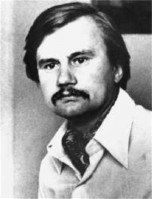
|
KALYNETS, IHOR, b 9 July 1939 in Khodoriv, Lviv oblast. Poet. A graduate of Lviv University (1961), Kalynets was employed at the Lviv Oblast State Archive. In 1972 he and his wife, Iryna Kalynets, were victims of a wave of political arrests. Both were imprisoned; he--for 'anti-Soviet activity' (ie, because his poetry had been published in the West) to six years in labor camp and three years of exile. In May-June 1974 Kalynets took part in a hunger strike of political prisoners in a Perm region labor camp; later he signed several appeals from political prisoners to the authorities. Since his release from exile in Chita oblast in 1981, Kalynets has lived in Lviv, his poetic muse silenced. In 1987 he became one of the editors of the almanac Yevshan-zillia, one of the first uncensored Ukrainian published periodicals established during the perestroika period. Inspired by the imagistic verse of Bohdan Ihor Antonych, Kalynets developed his poetry into the finest exponent of modern Ukrainian 'engage' lyricism. He employs images that are often primeval and a vocabulary that is rich in cultural allusions while using a prosodic cadence that is contemporary. His collection Vohon' Kupala (The Fire of Kupalo) was published in Kyiv in 1966 but was immediately suppressed and all copies were confiscated. From that time until the late 1980s his poetry was blacklisted in the USSR and distributed only via samvydav publications. He was officially published only in the West. Since 1991 editions of Kalynets's poetry have also regularly appeared in Ukraine. In 1994 he published a short novel Molimos' zoriam dal'nim (Let's Pray to Distant Stars), written in 1972 during his incarceration in a Lviv prison... |
| Ihor Kalynets |
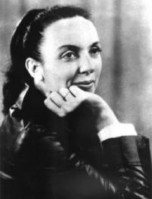
|
KALYNETS, IRYNA (nee Stasiv), b 6 December 1940 in Lviv, d 31 July 2012 in Lviv. Dissident; wife of Ihor Kalynets. A graduate of Lviv University, she taught Ukrainian language and literature at the Lviv Polytechnical Institute and published children's stories and verses. An active defender of Valentyn Moroz in 1970 and a founding member of the Committee in Defense of Nina Strokata in 1971, she was arrested in Lviv in January 1972 and sentenced in August for anti-Soviet agitation and propaganda to six years in prison and three years of exile. In the labor camps of Mordovia, where she served her sentence, she joined protests against camp conditions and made demands for the recognition of political prisoners. After serving her term of exile in Chita oblast, she was released in 1981 and returned to Lviv. In the late 1980s she became an active campaigner for the restoration of the Ukrainian Catholic Church. In 1990 she was elected to the Supreme Soviet of the Ukrainian SSR. Also in 1990 she became head of the Lviv Oblast Education Administration and took an active part in the reforms of the Ukrainian education system... |
| Iryna Kalynets |
The preparation, editing, and display of the IEU entries about the Ukrainian dissident writers of the 1960s to 1980s were made possible by the financial support of the FOUNDATION OF THE ENCYCLOPEDIA OF UKRAINE (Toronto, ON, Canada).
ABOUT IEU: Once completed, the Internet Encyclopedia of Ukraine will be the most comprehensive source of information in English on Ukraine, its history, people, geography, society, economy, and cultural heritage. With over 20,000 detailed encyclopedic entries supplemented with thousands of maps, photographs, illustrations, tables, and other graphic and/or audio materials, this immense repository of knowledge is designed to present Ukraine and Ukrainians to the world.
At present, only 58% of the entire planned IEU database is available on the IEU site. New entries are being edited, updated, and added daily. However, the successful completion of this ambitious and costly project will be possible only with financial assistance from IEU supporters. Become an IEU supporter and help the CIUS in creating the world's most authoritative electronic information resource about Ukraine and Ukrainians!
|
Click Home to get to the IEU Home page; to contact the IEU editors click Contact. To learn more about IEU click About IEU and to view the list of donors and to become an IEU supporter click Donors. ©2001 All Rights Reserved. Canadian Institute of Ukrainian Studies. |
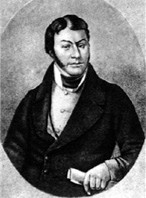
_s.jpg)
